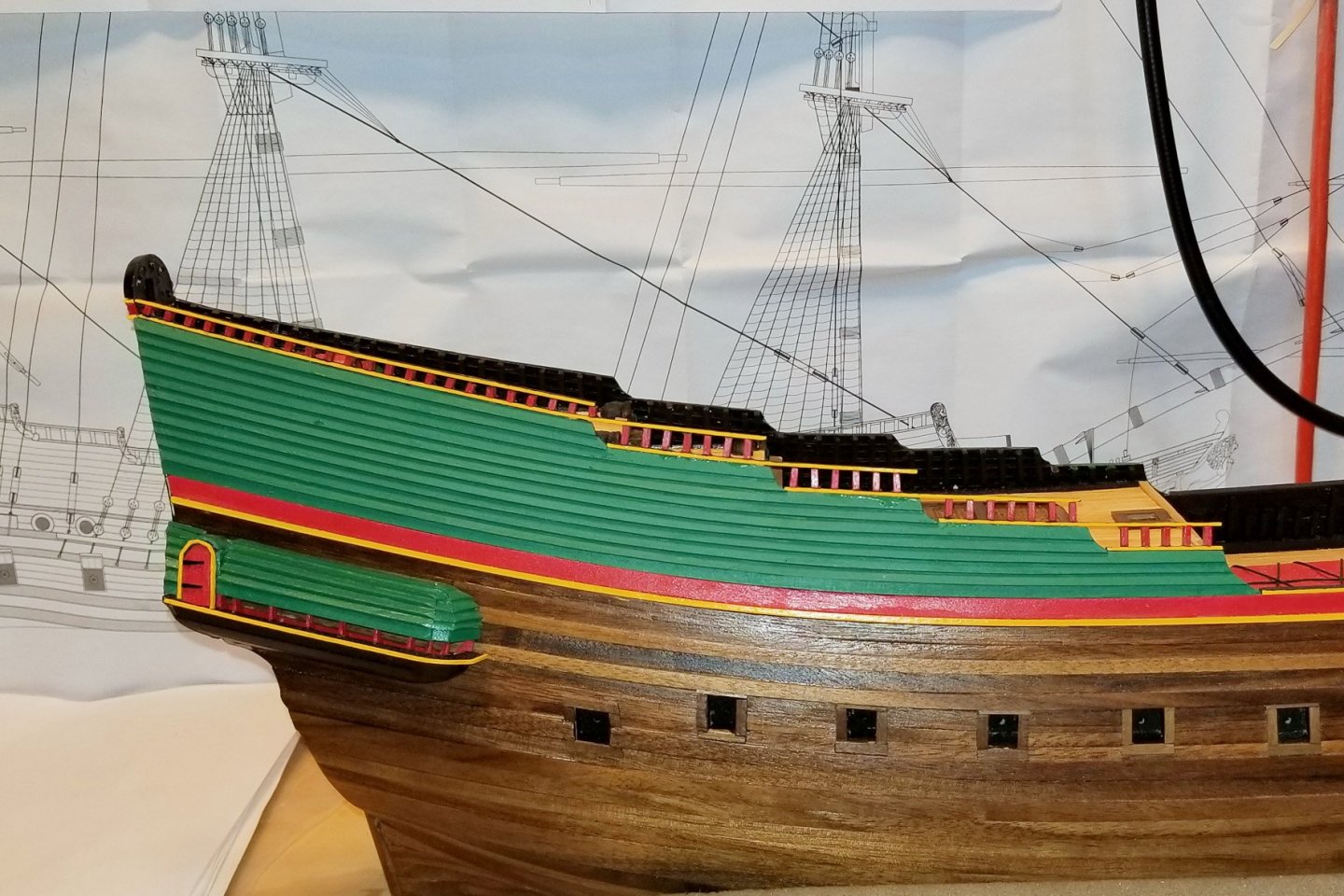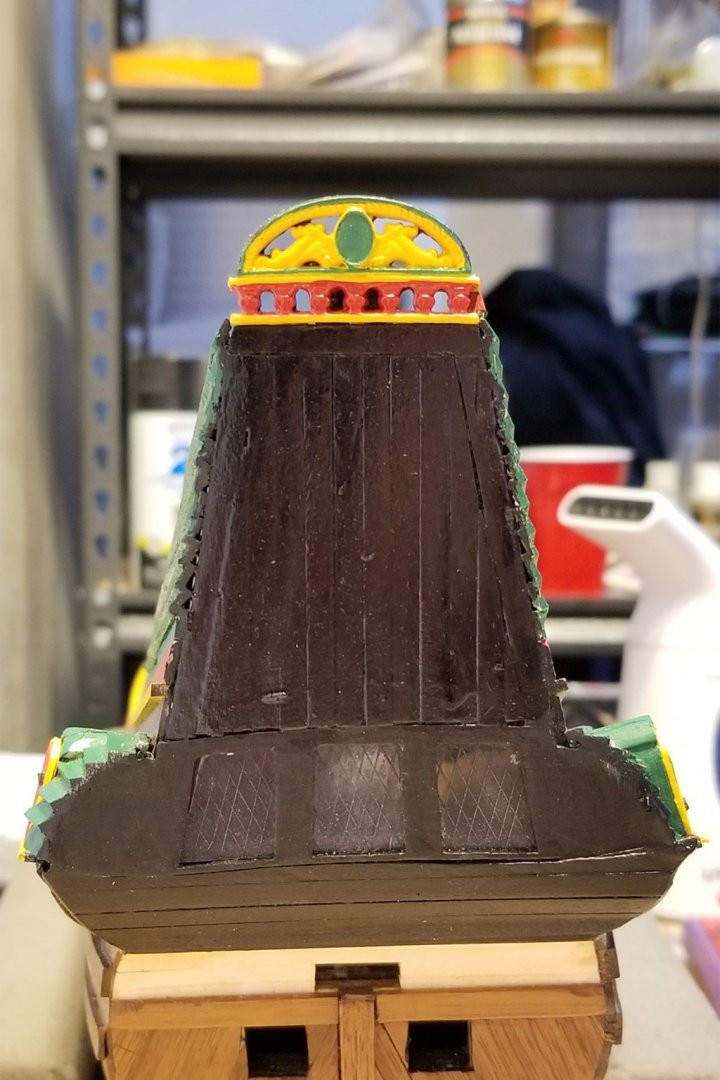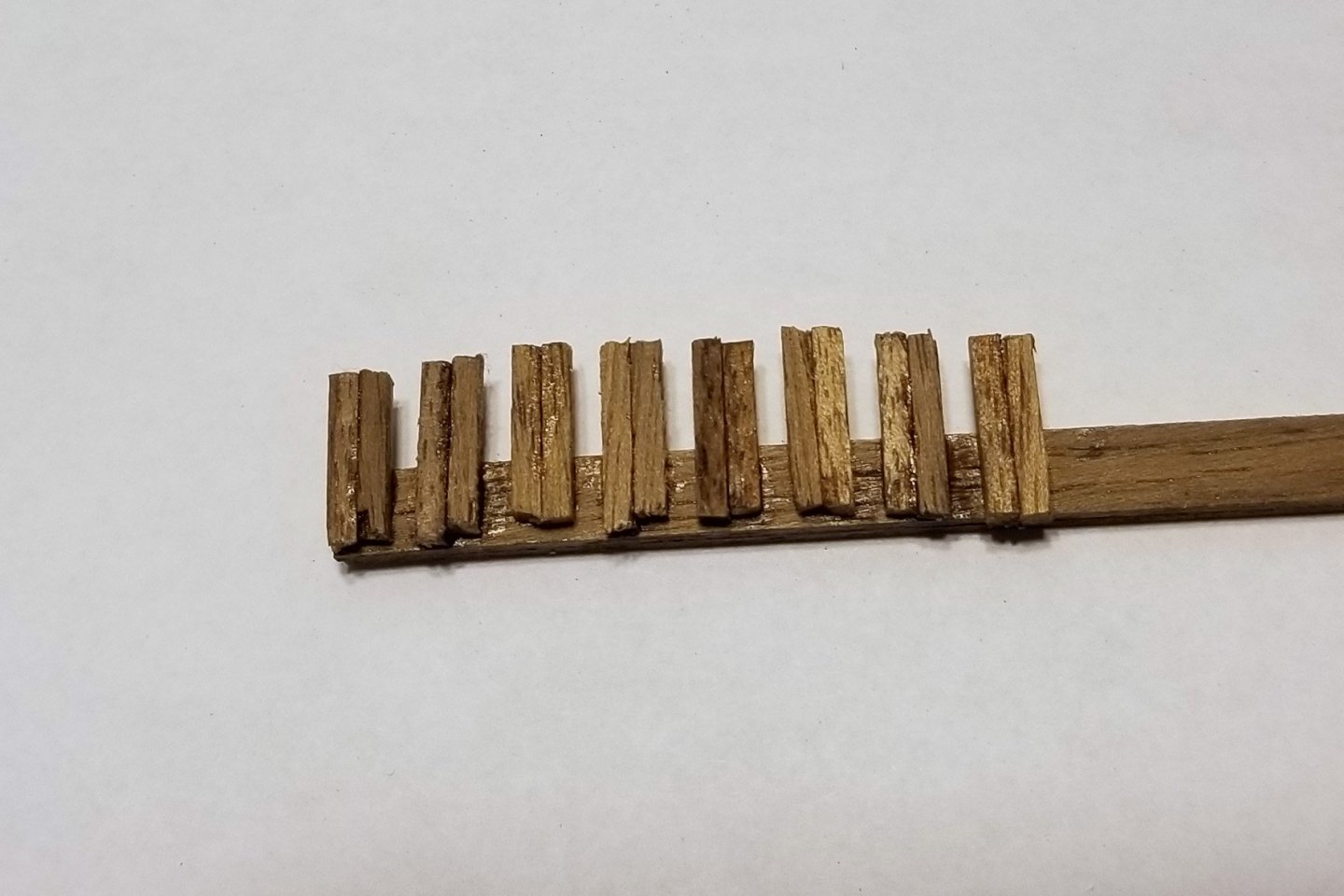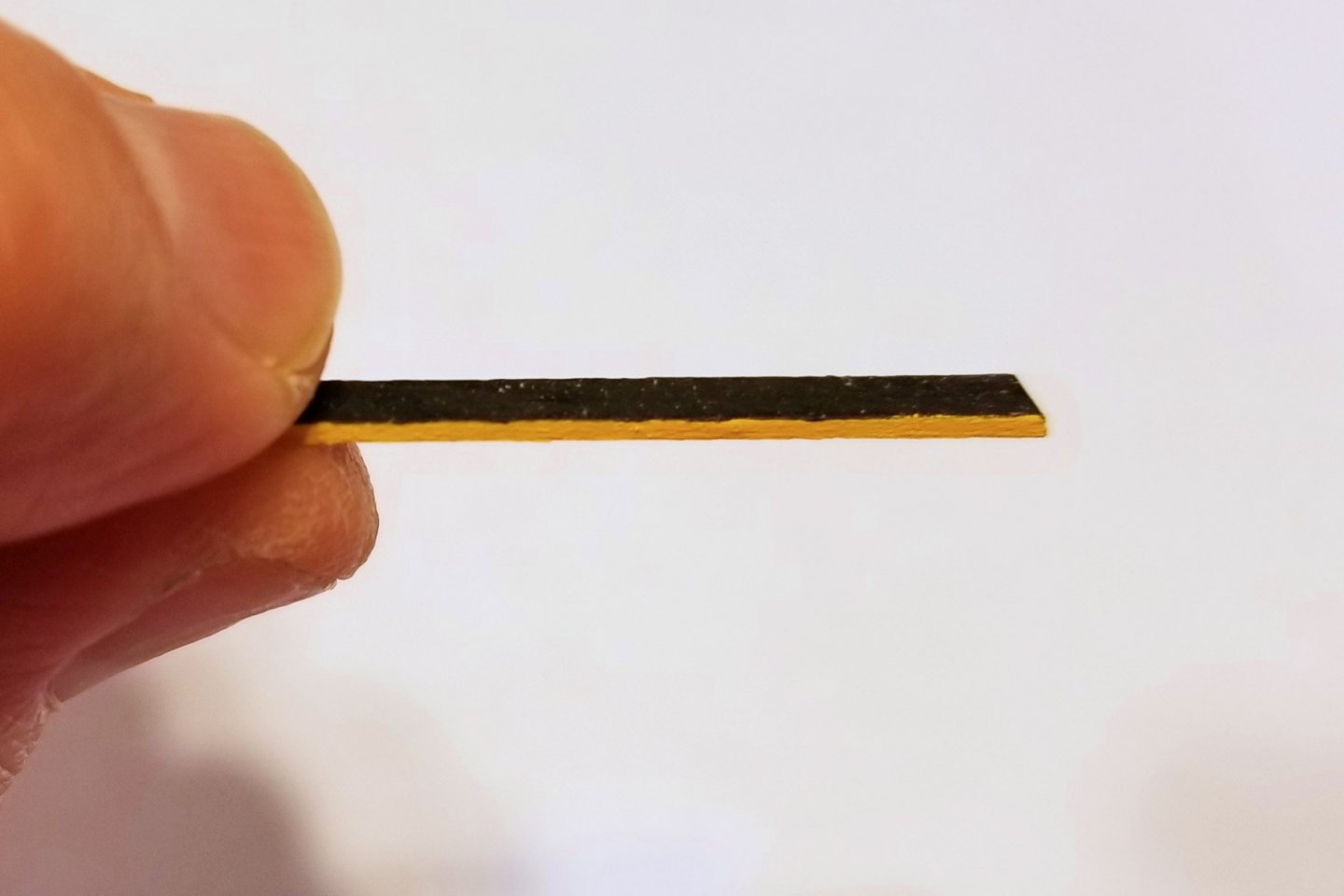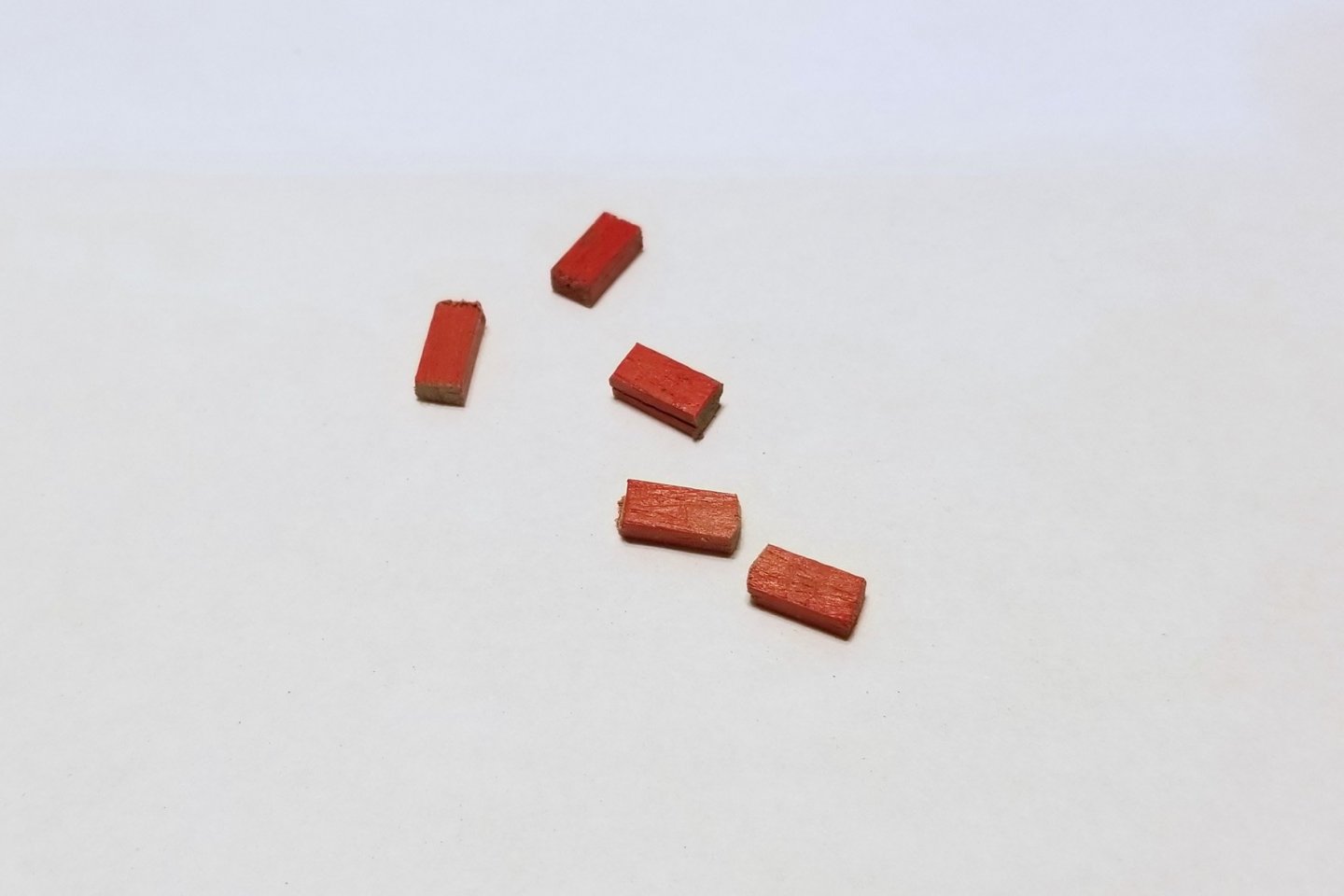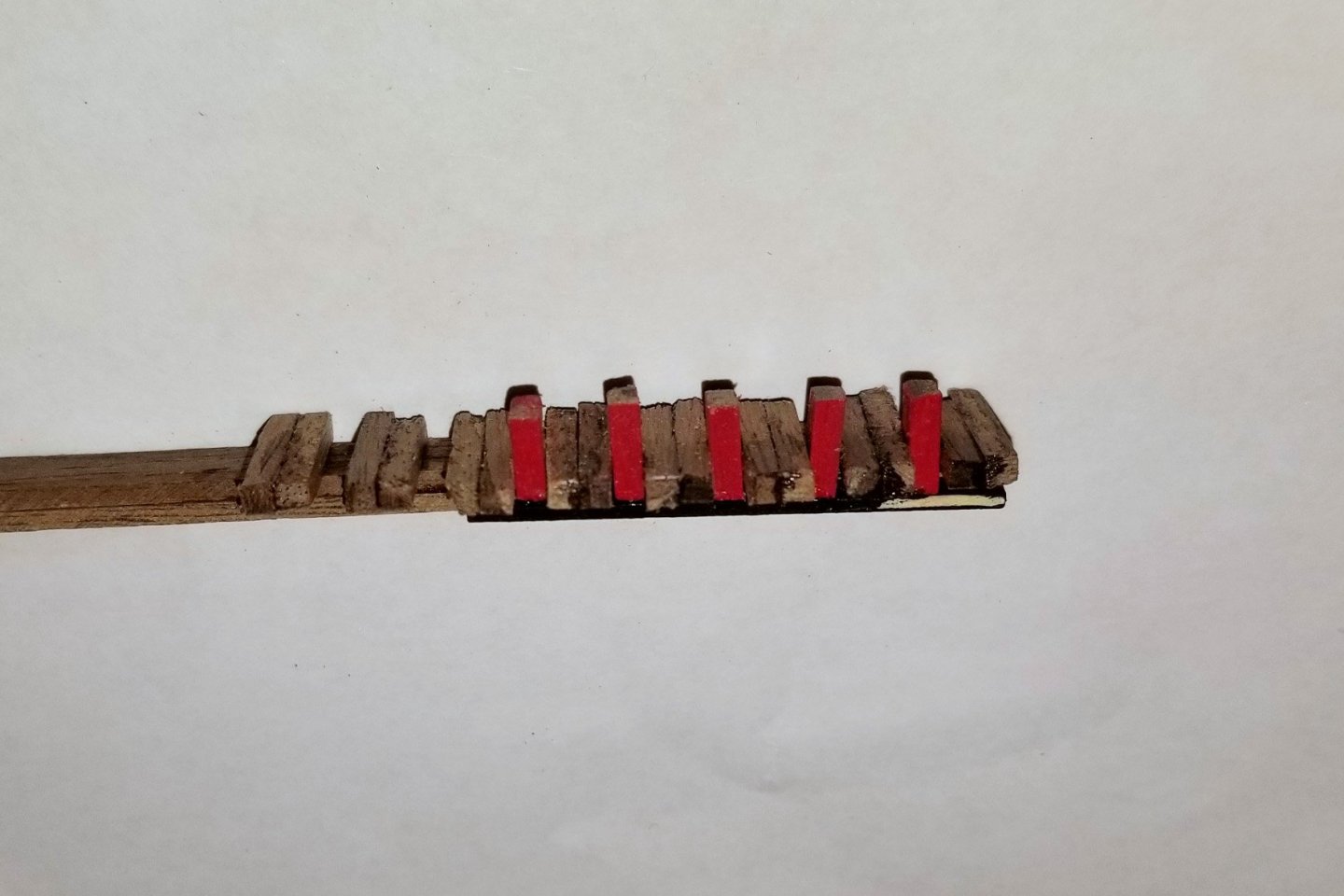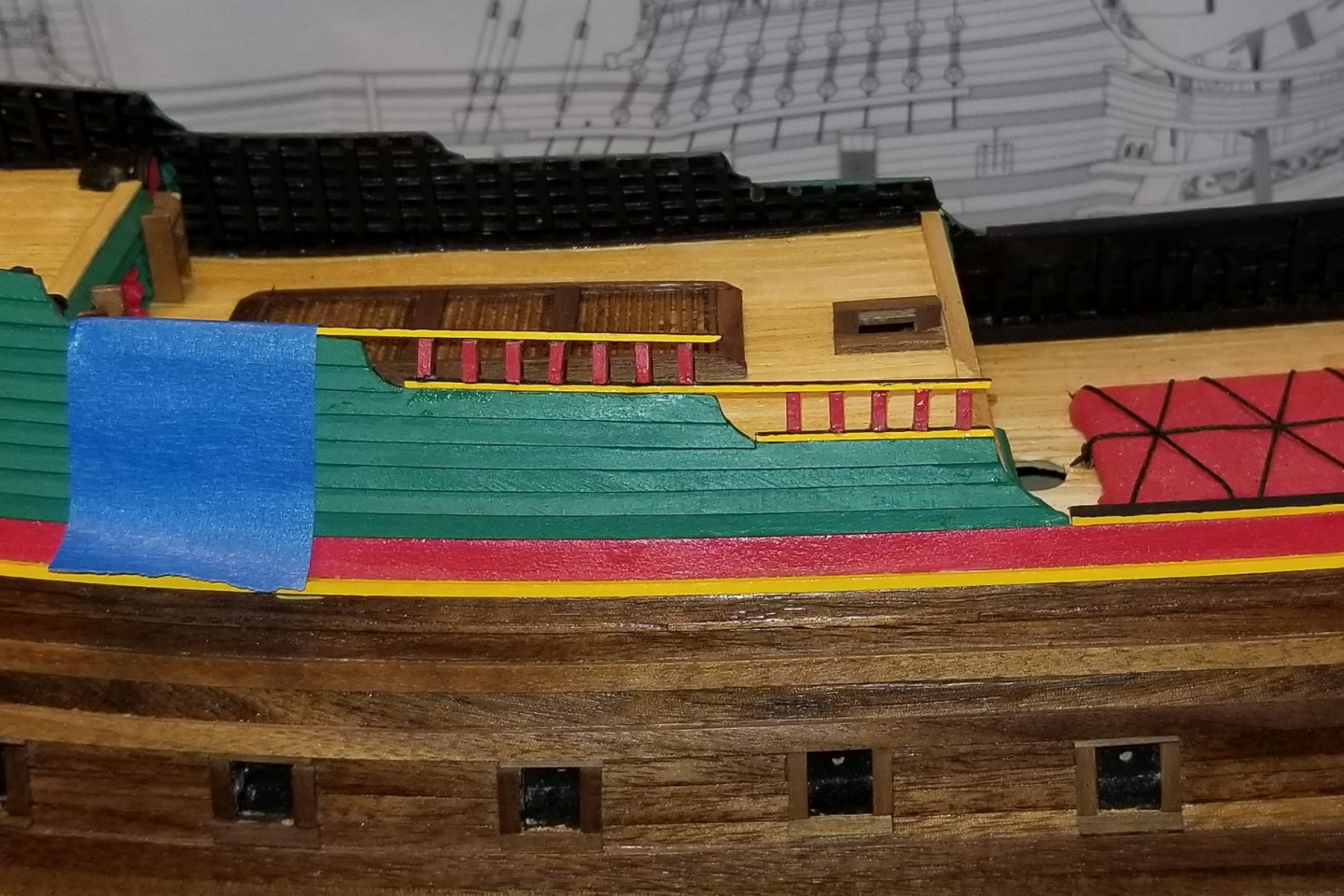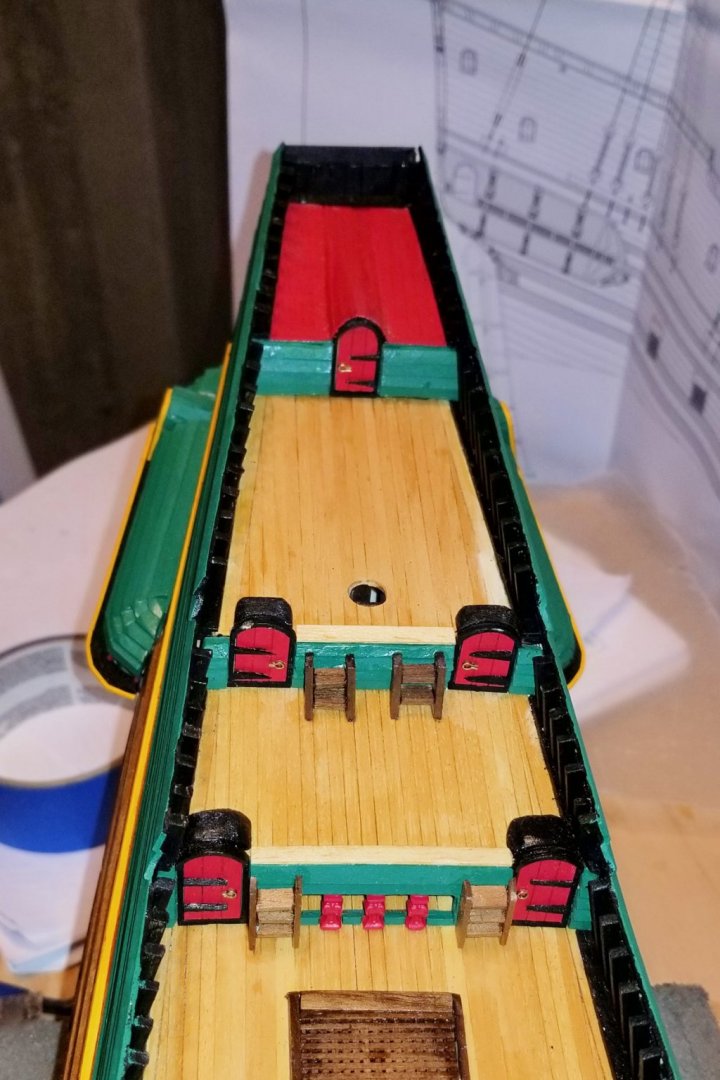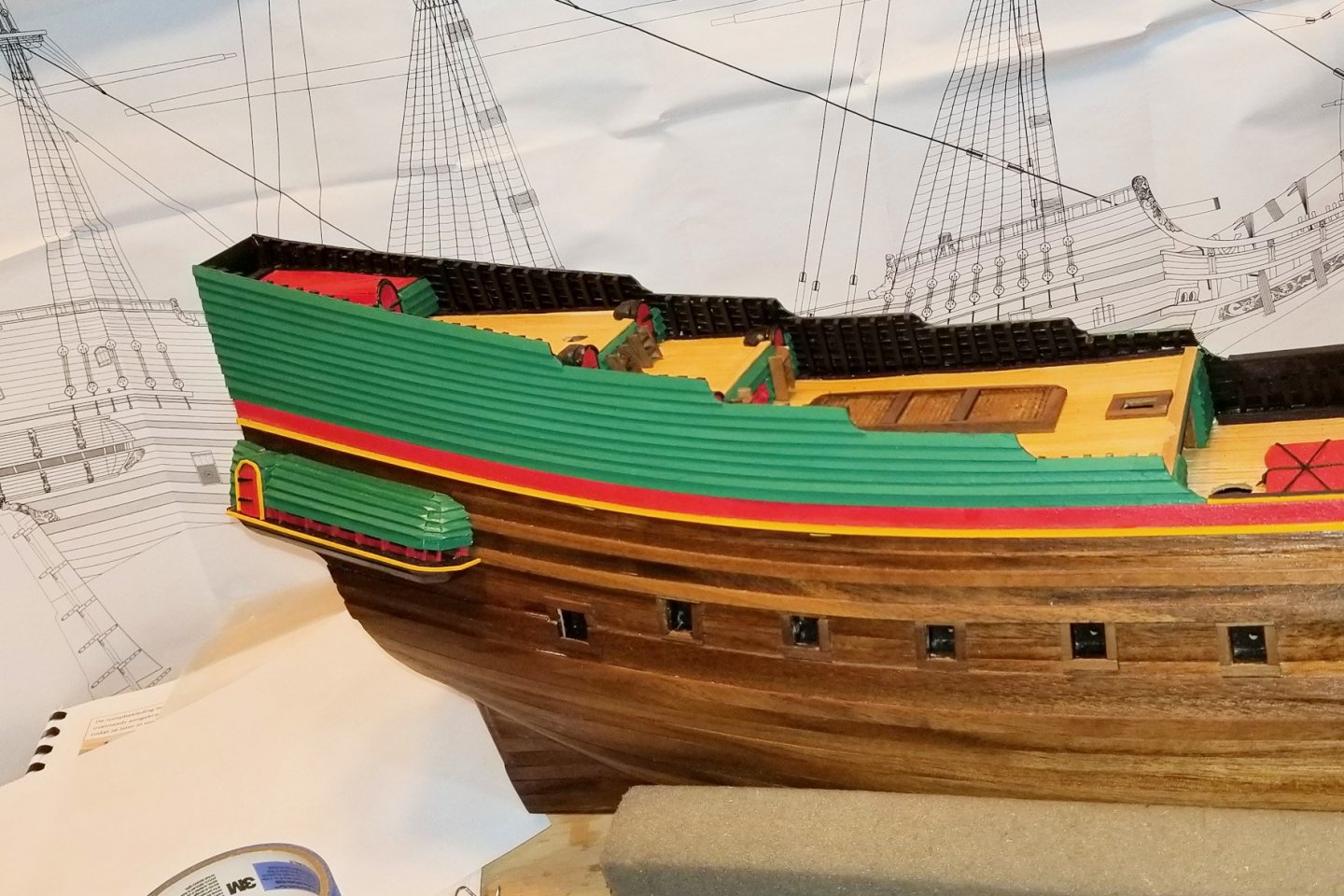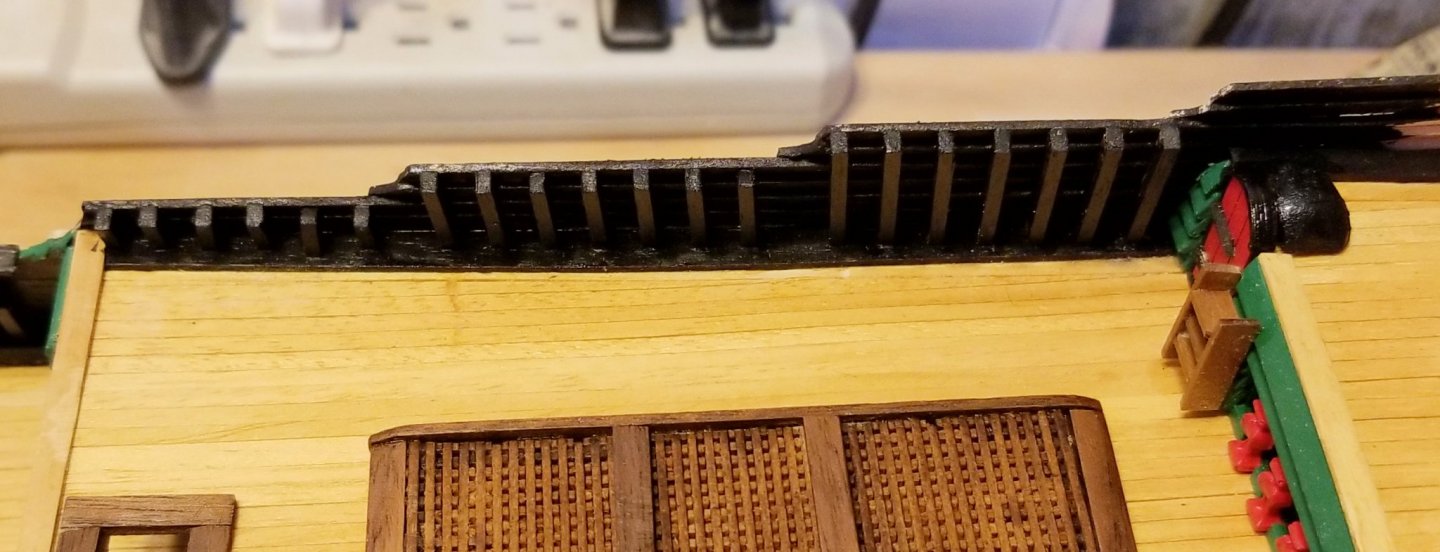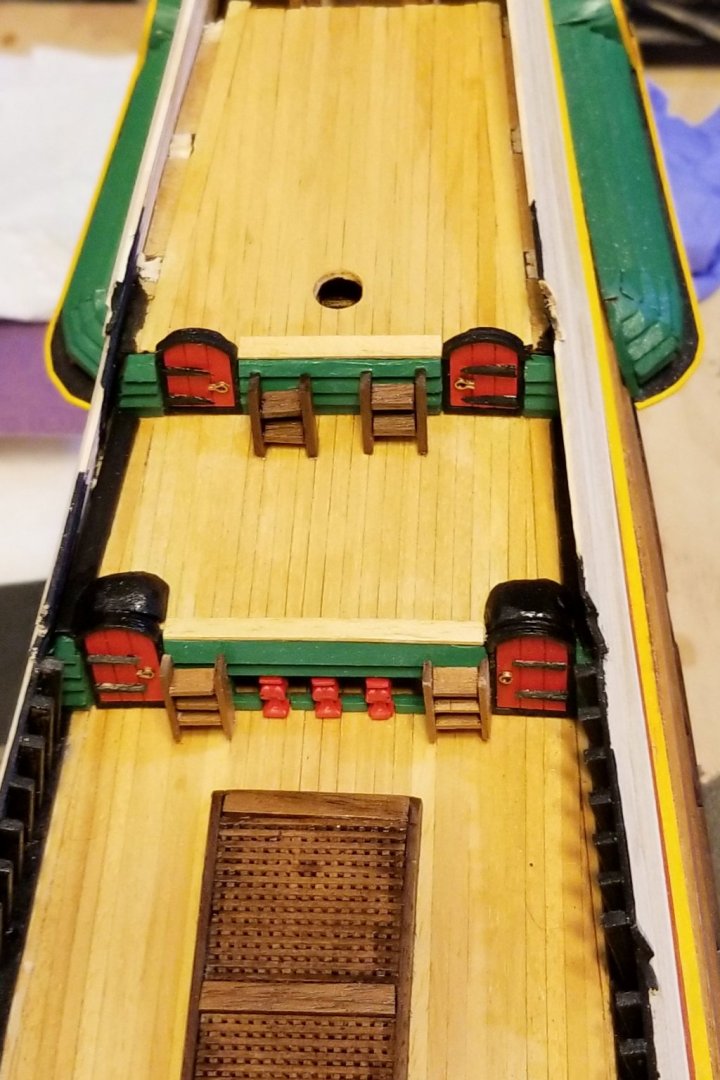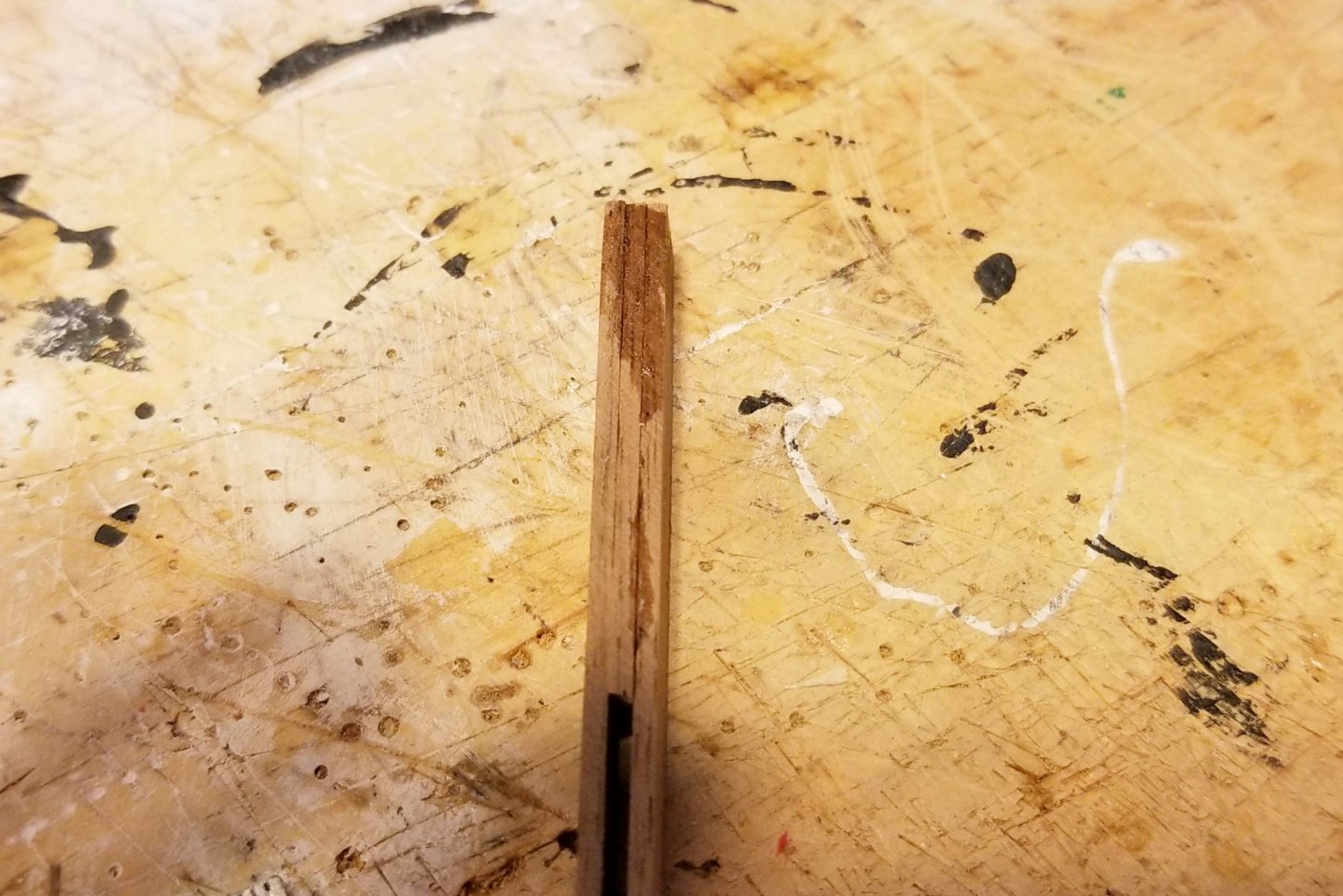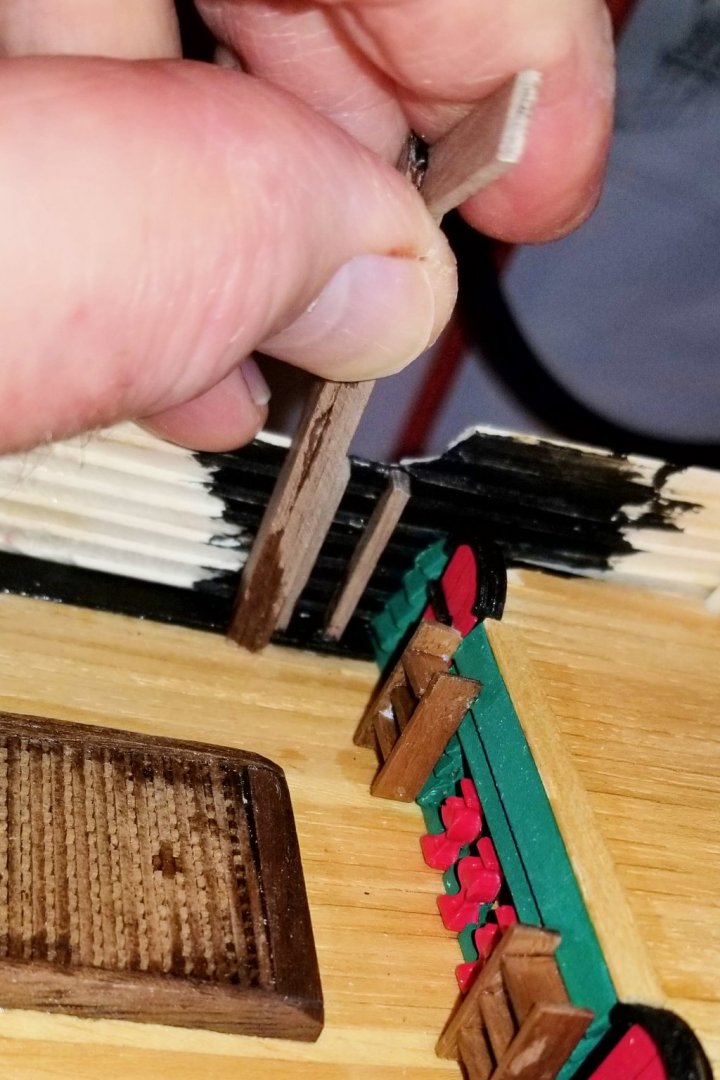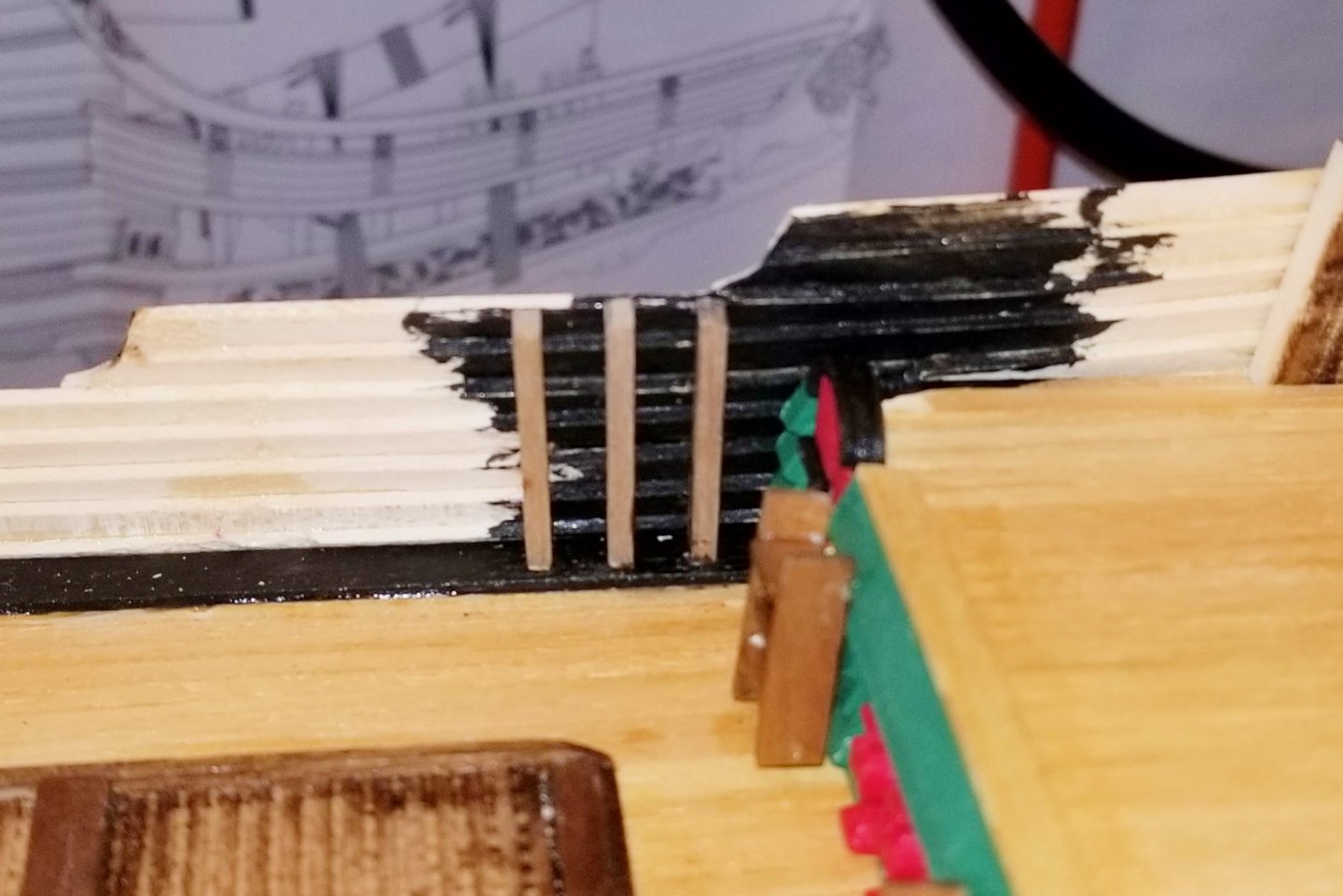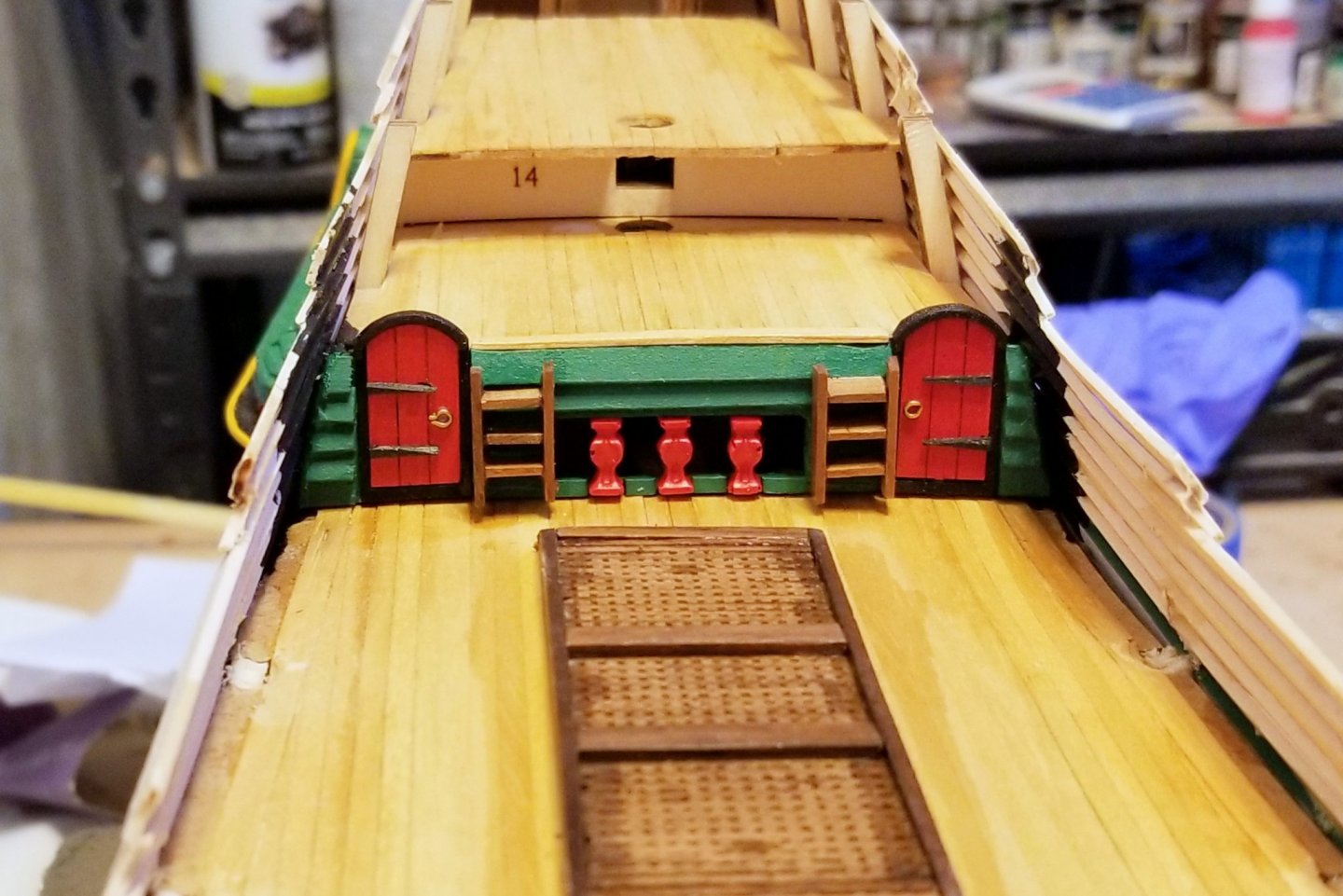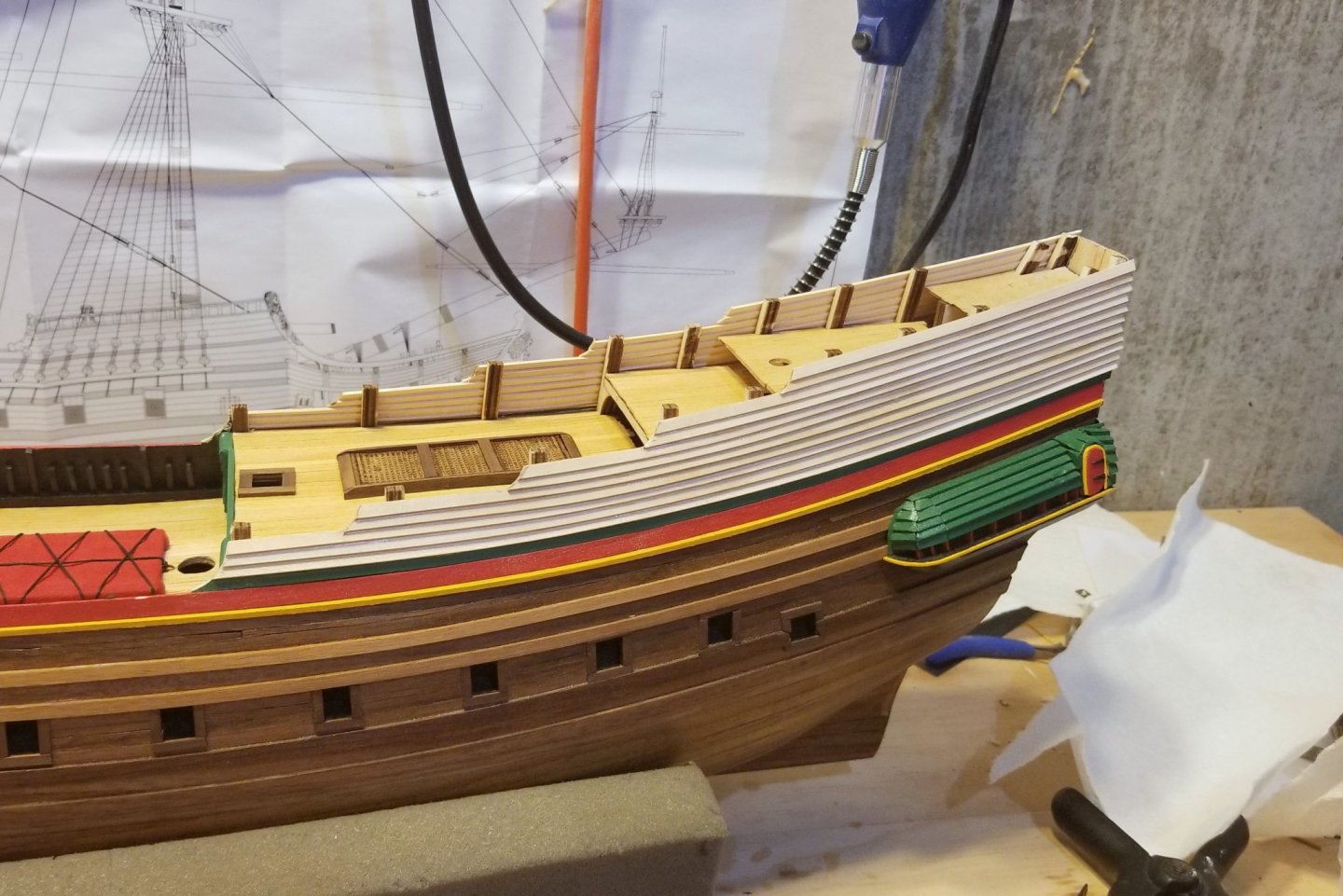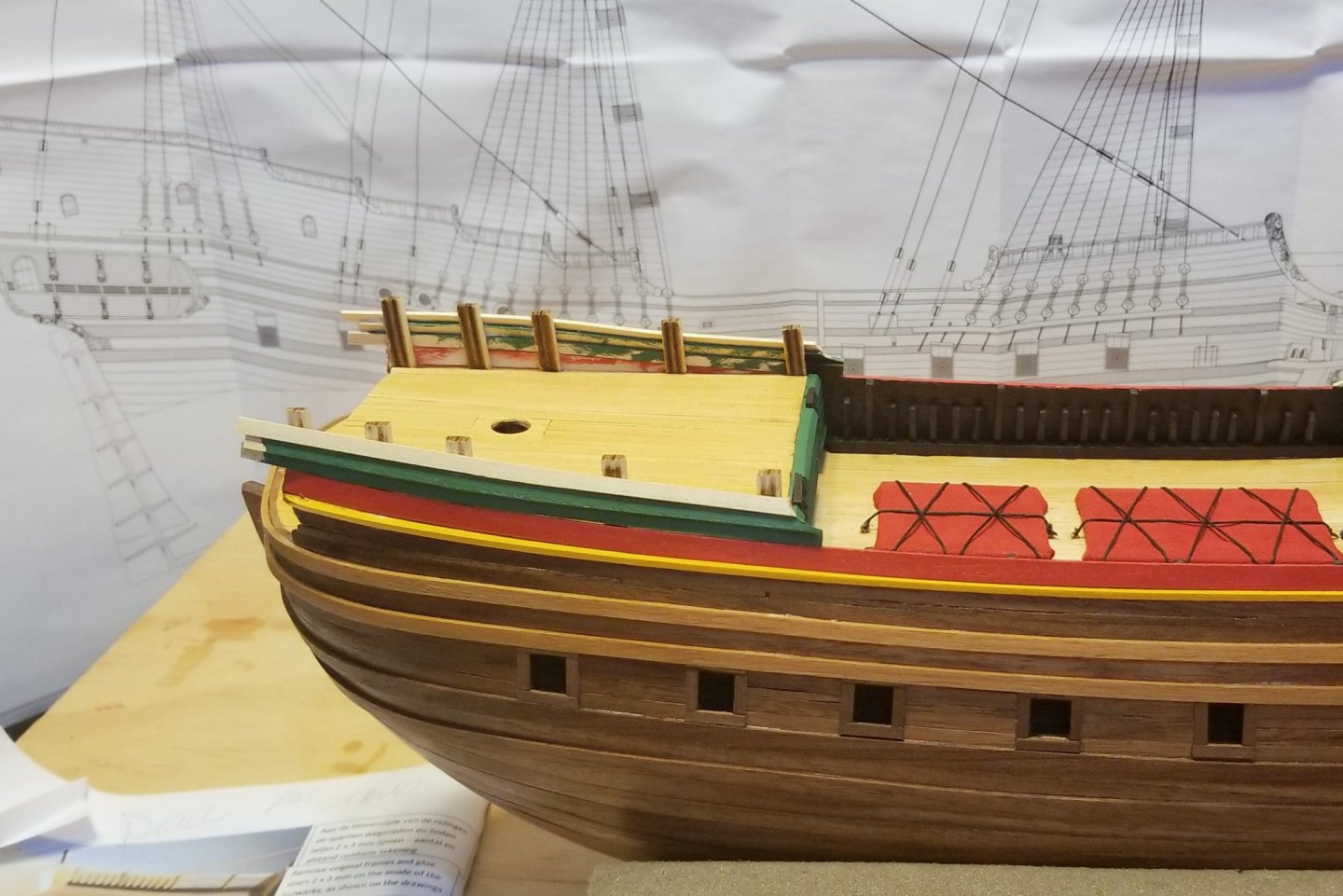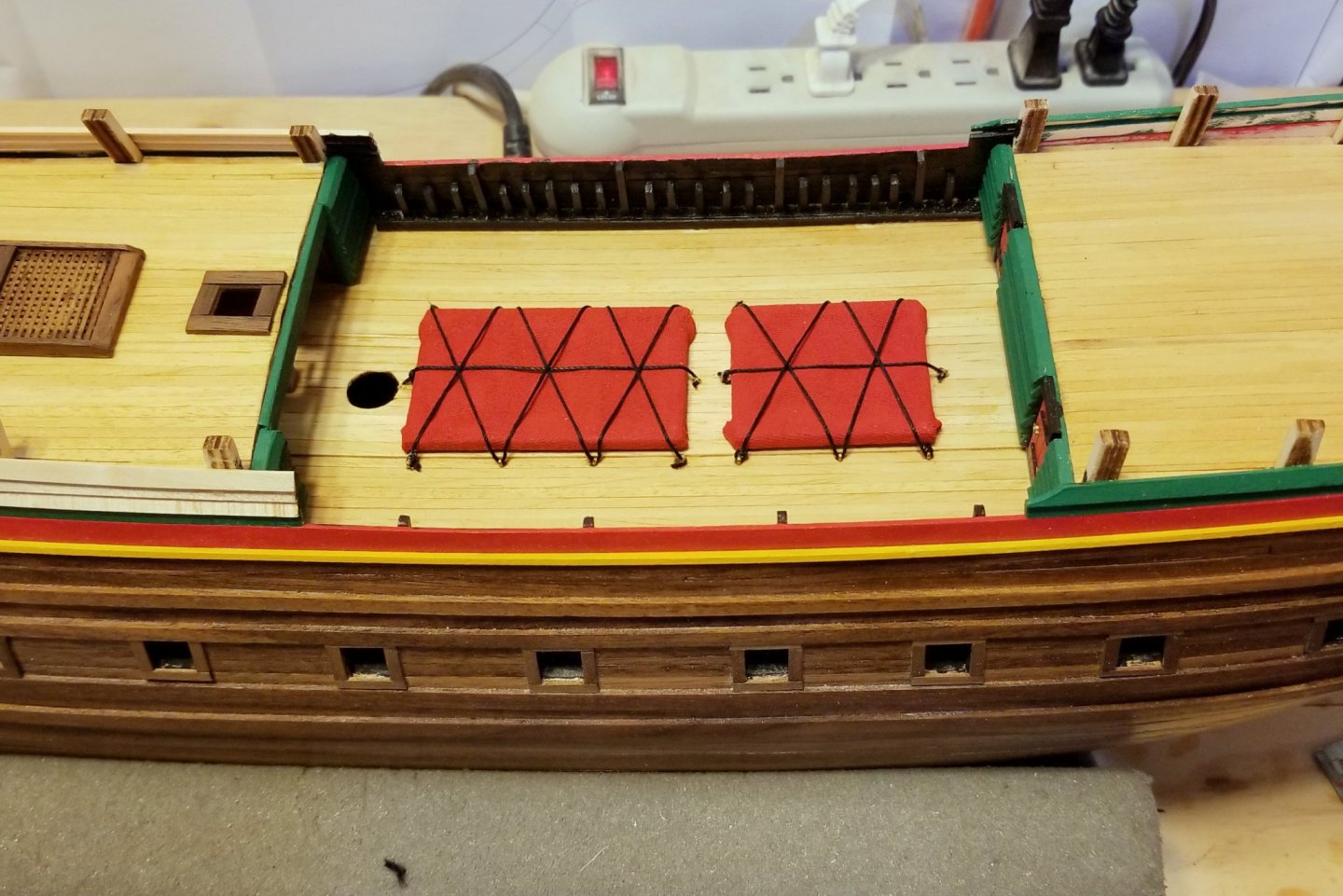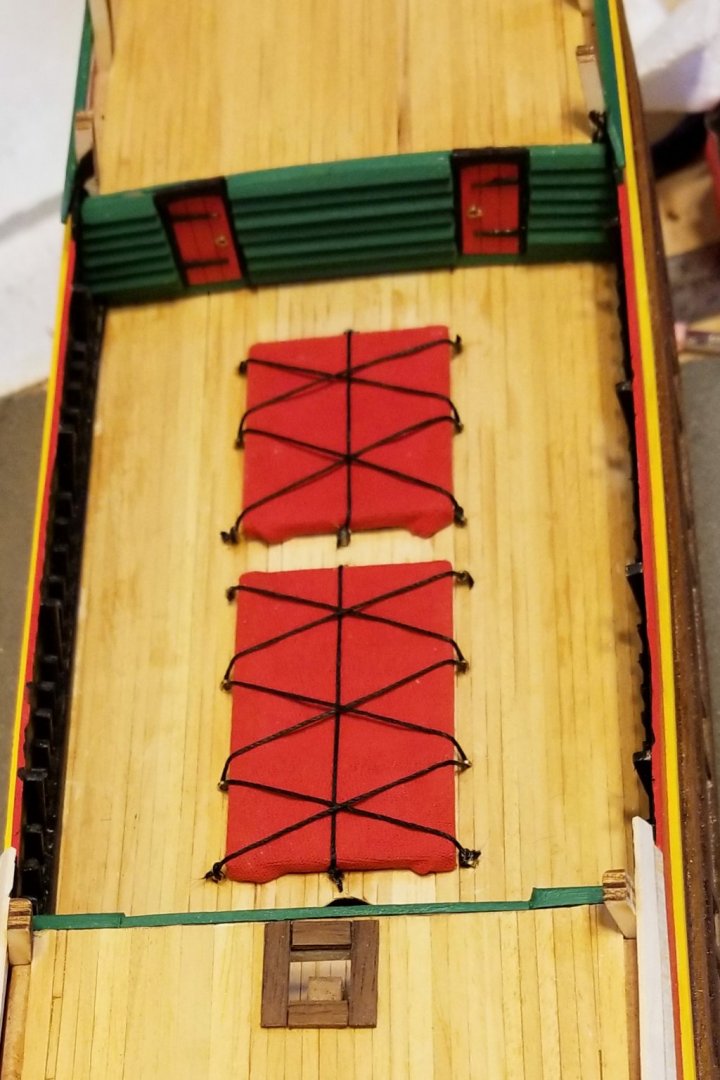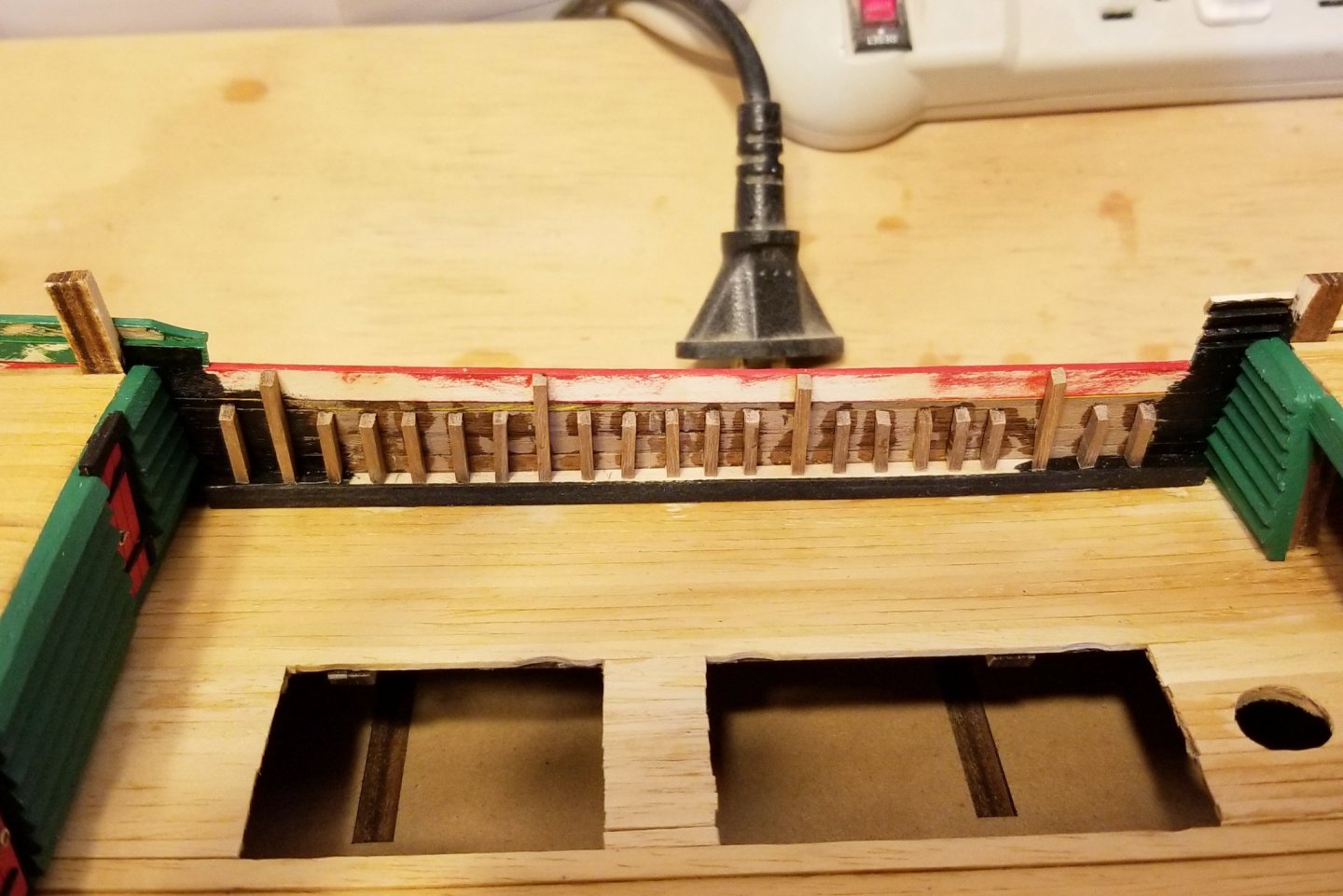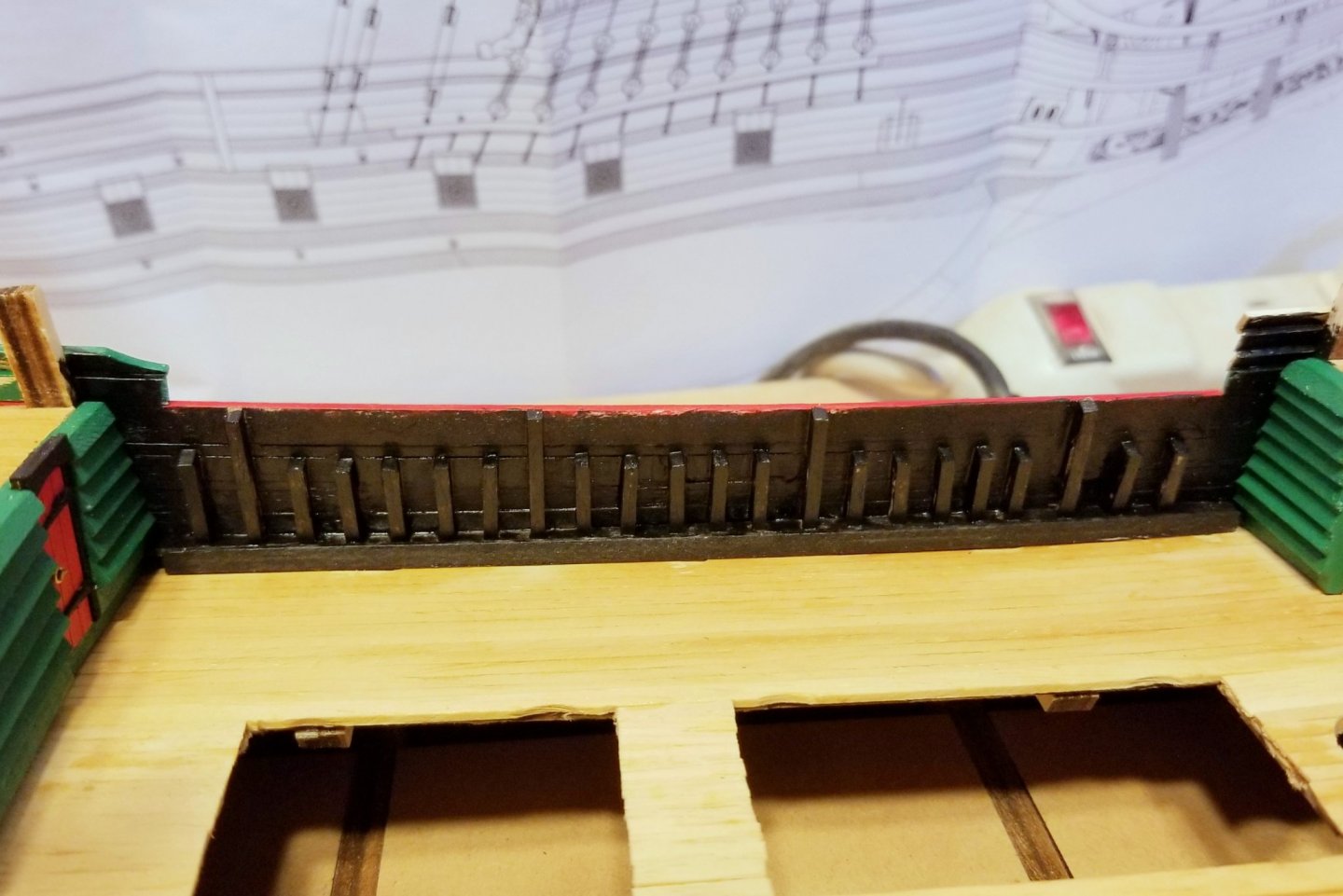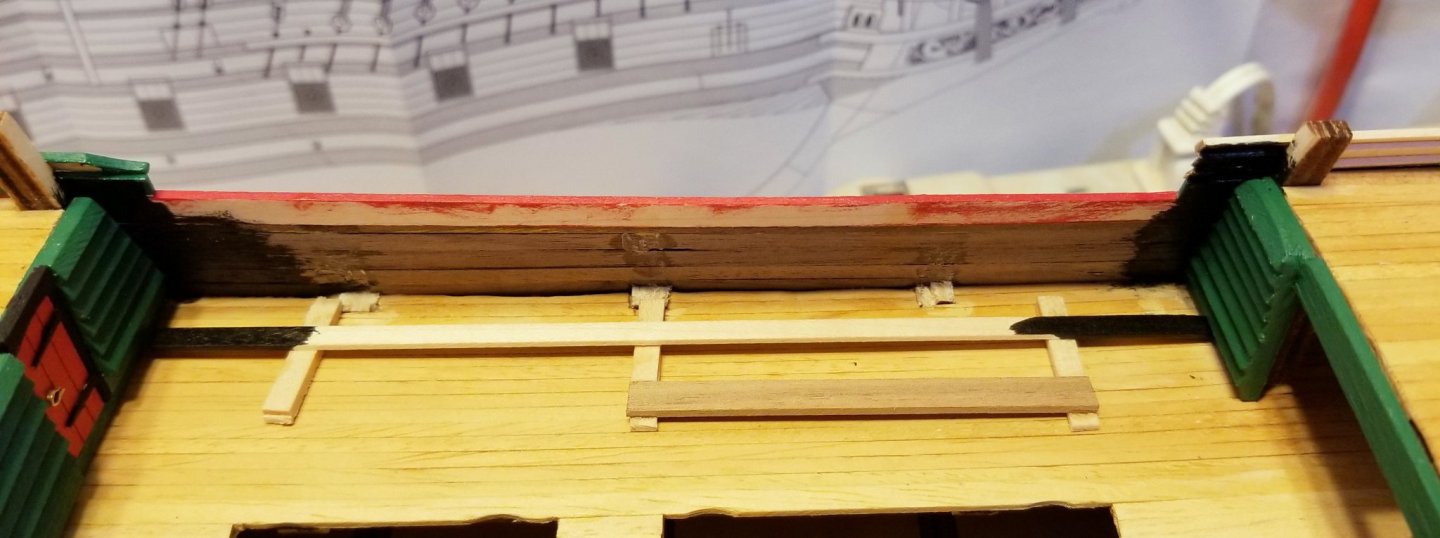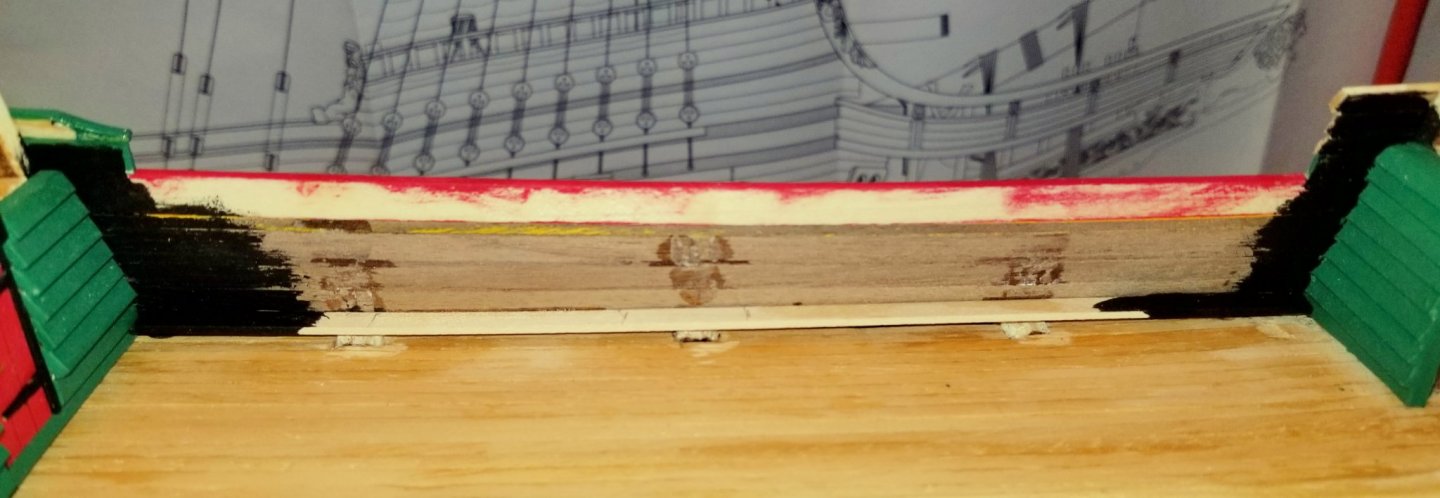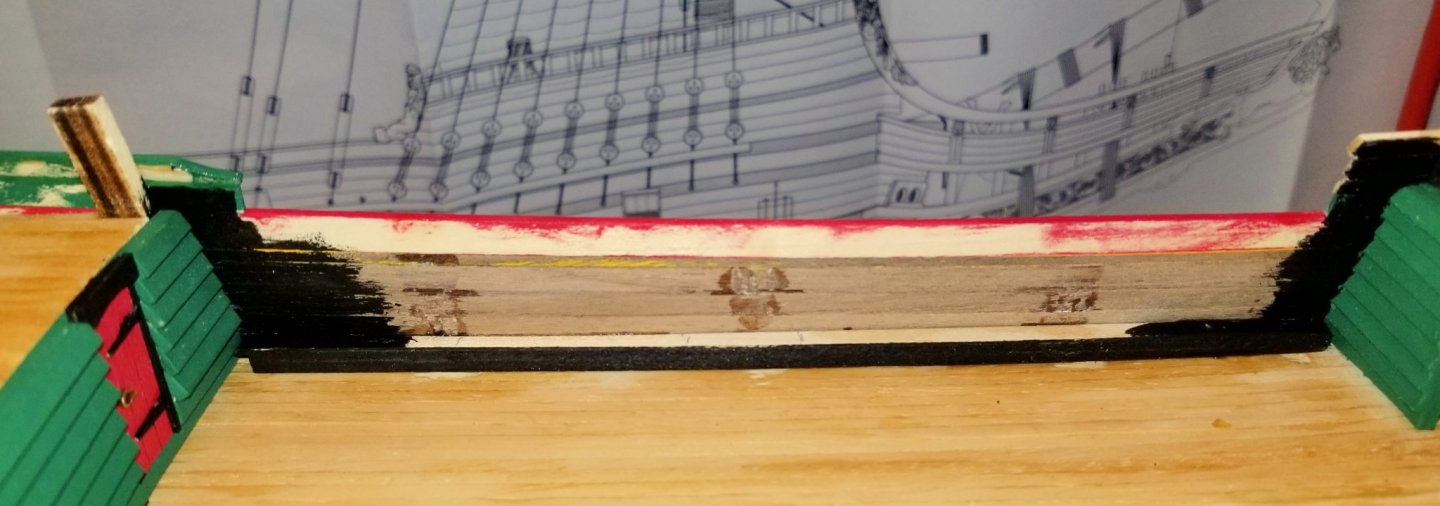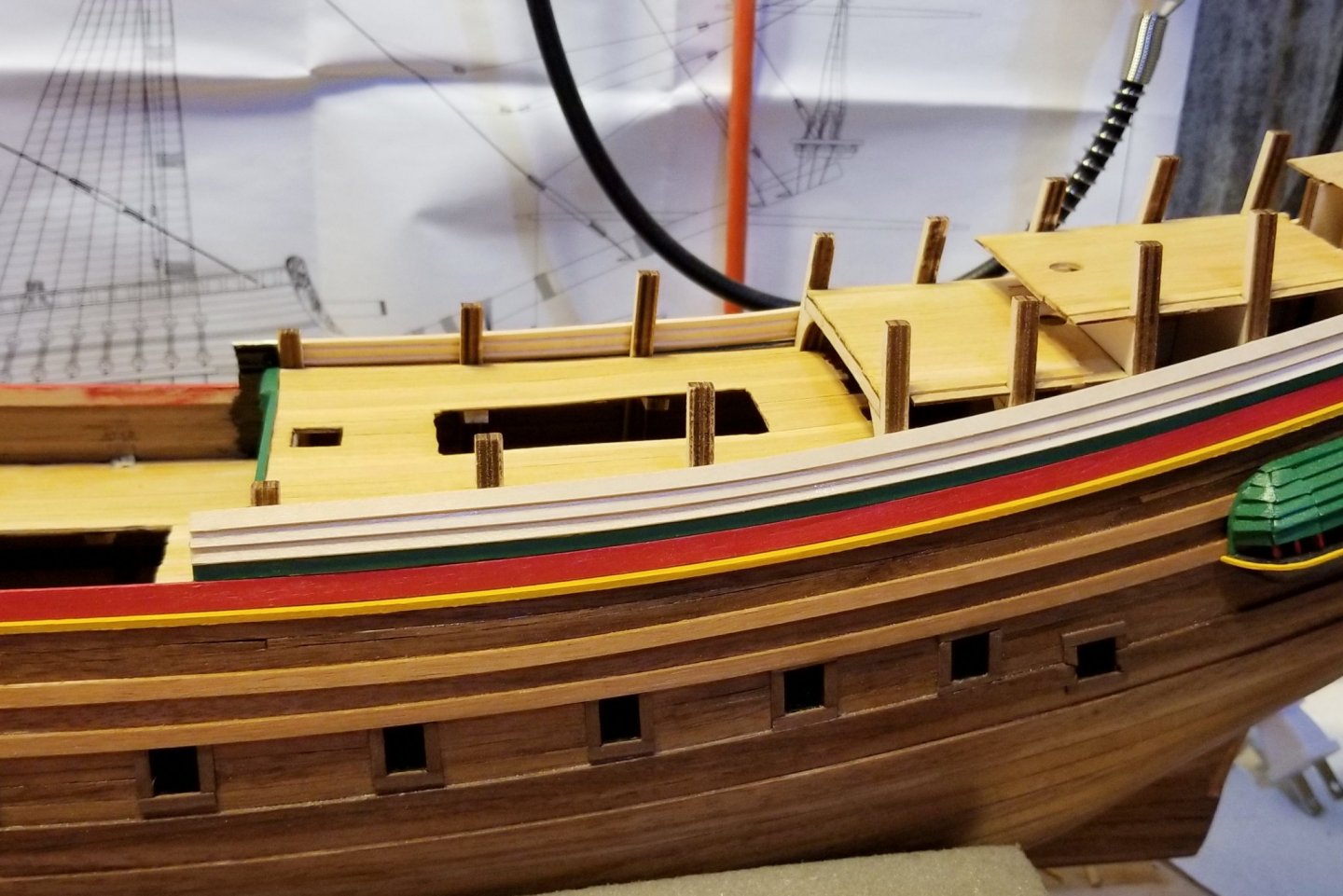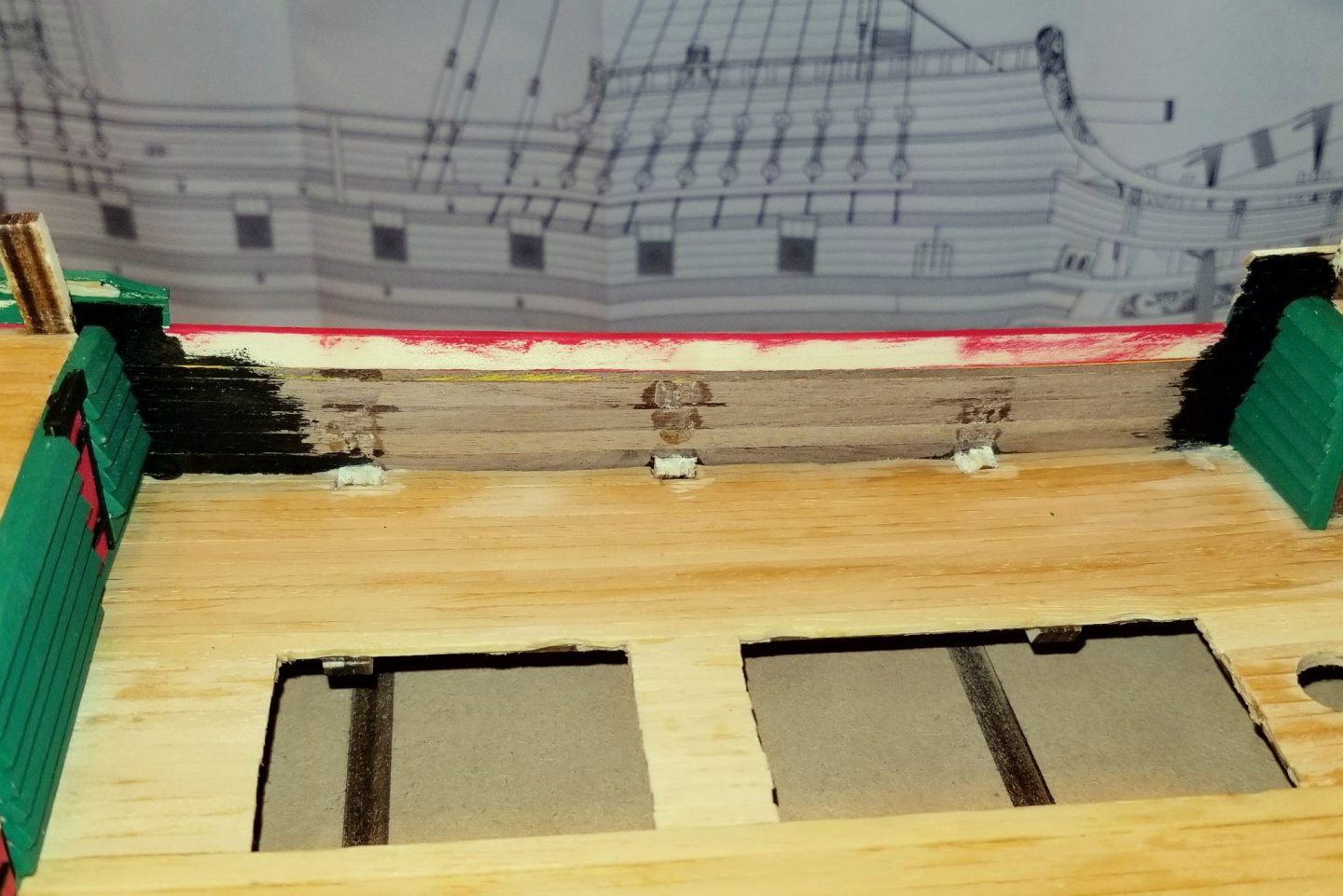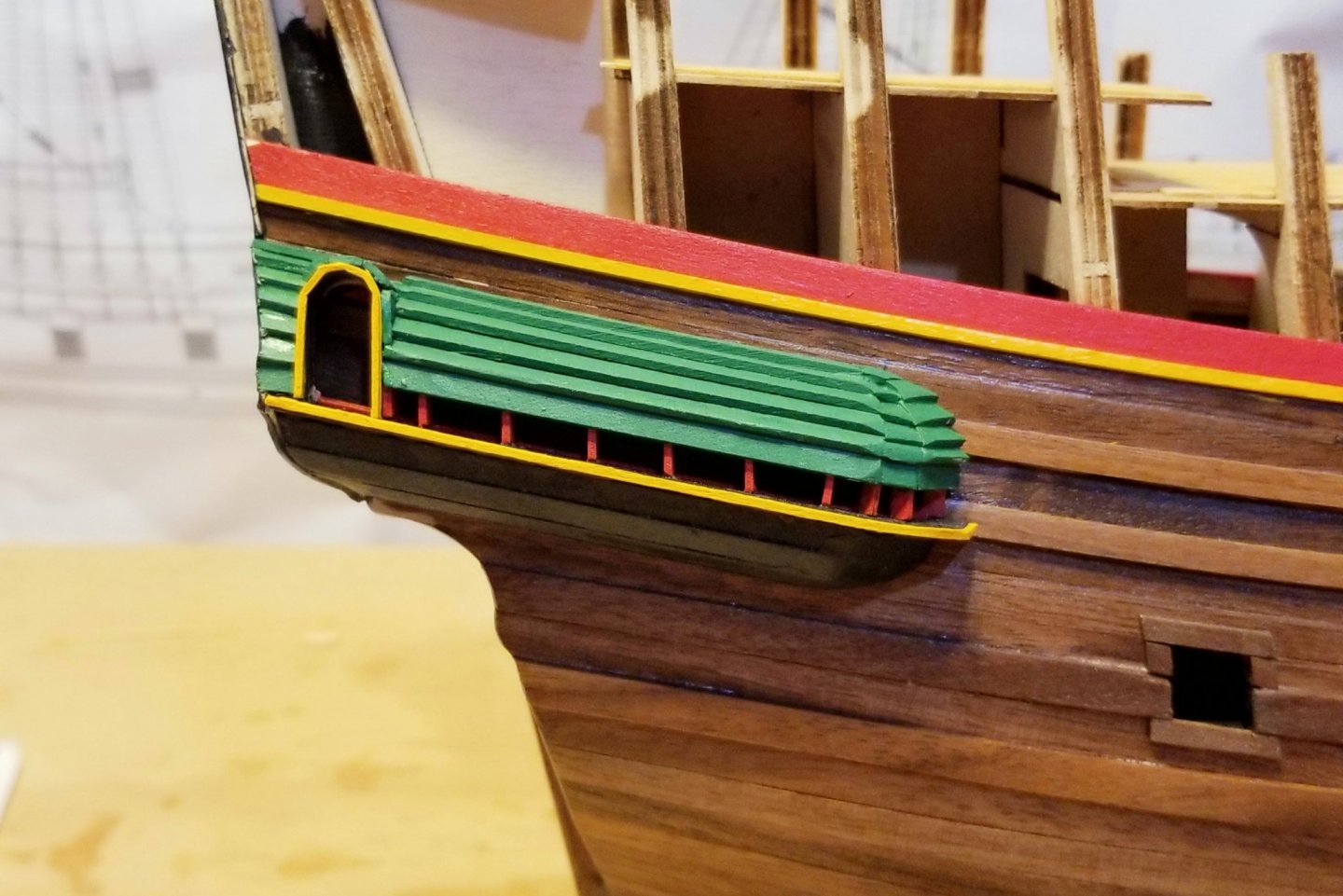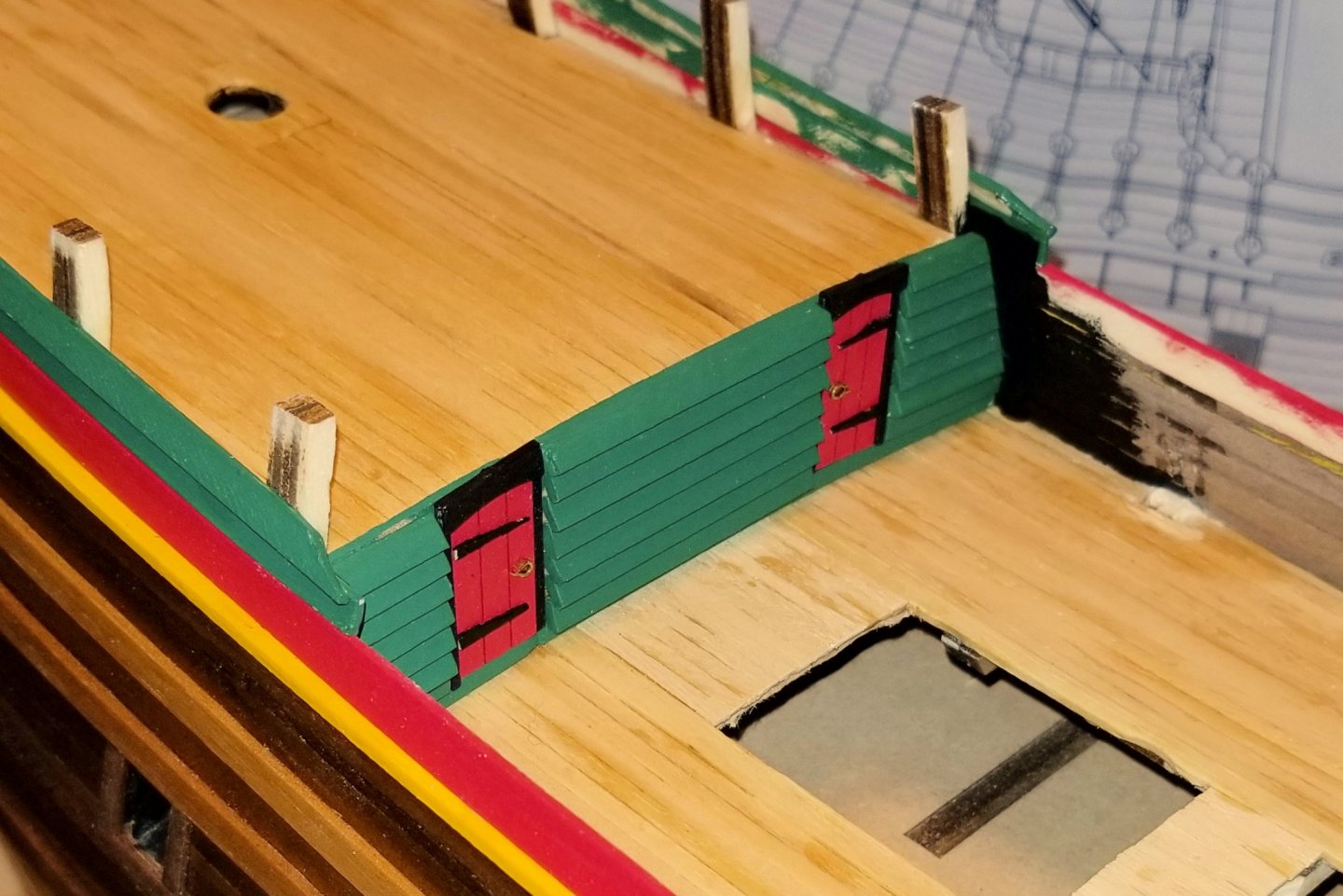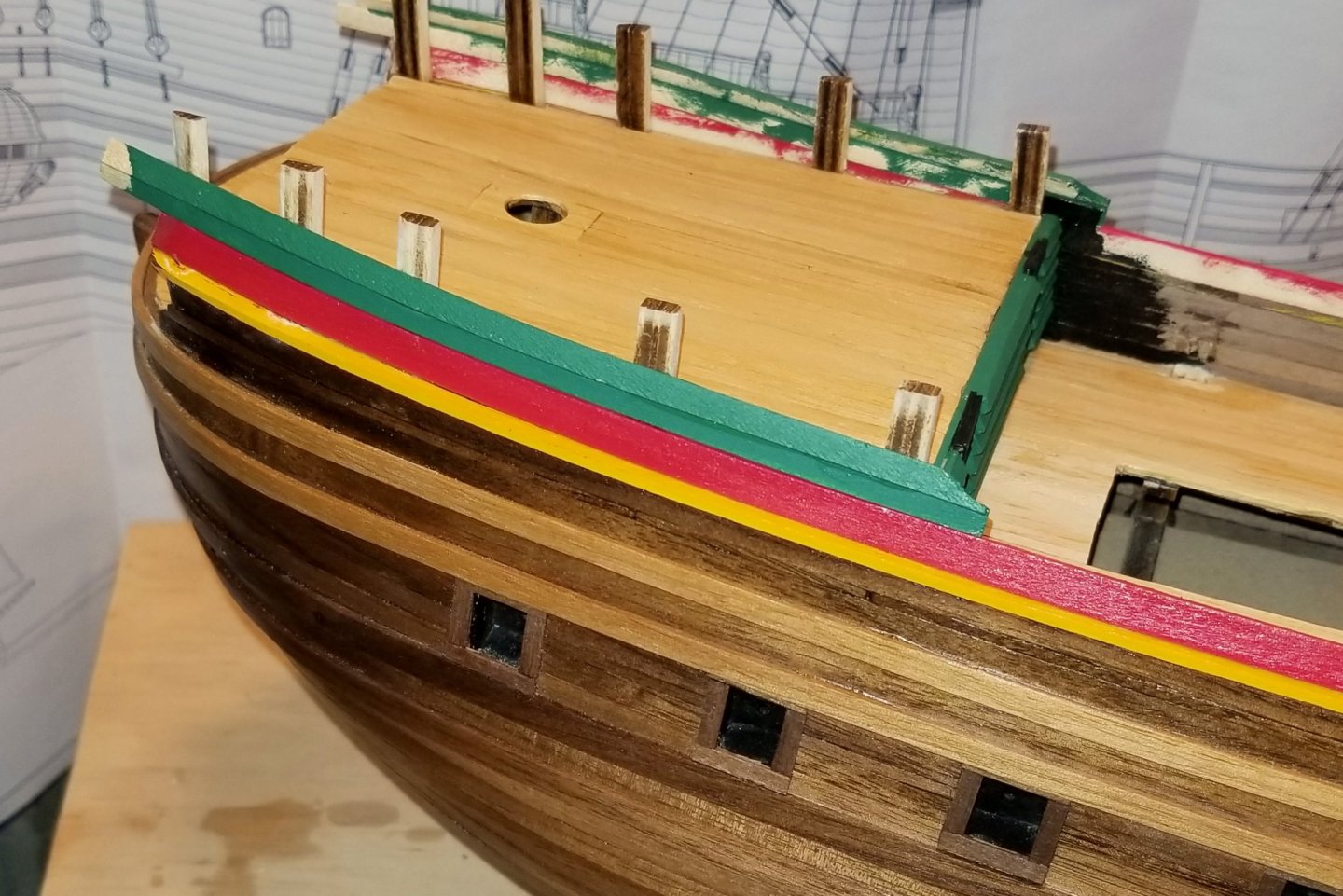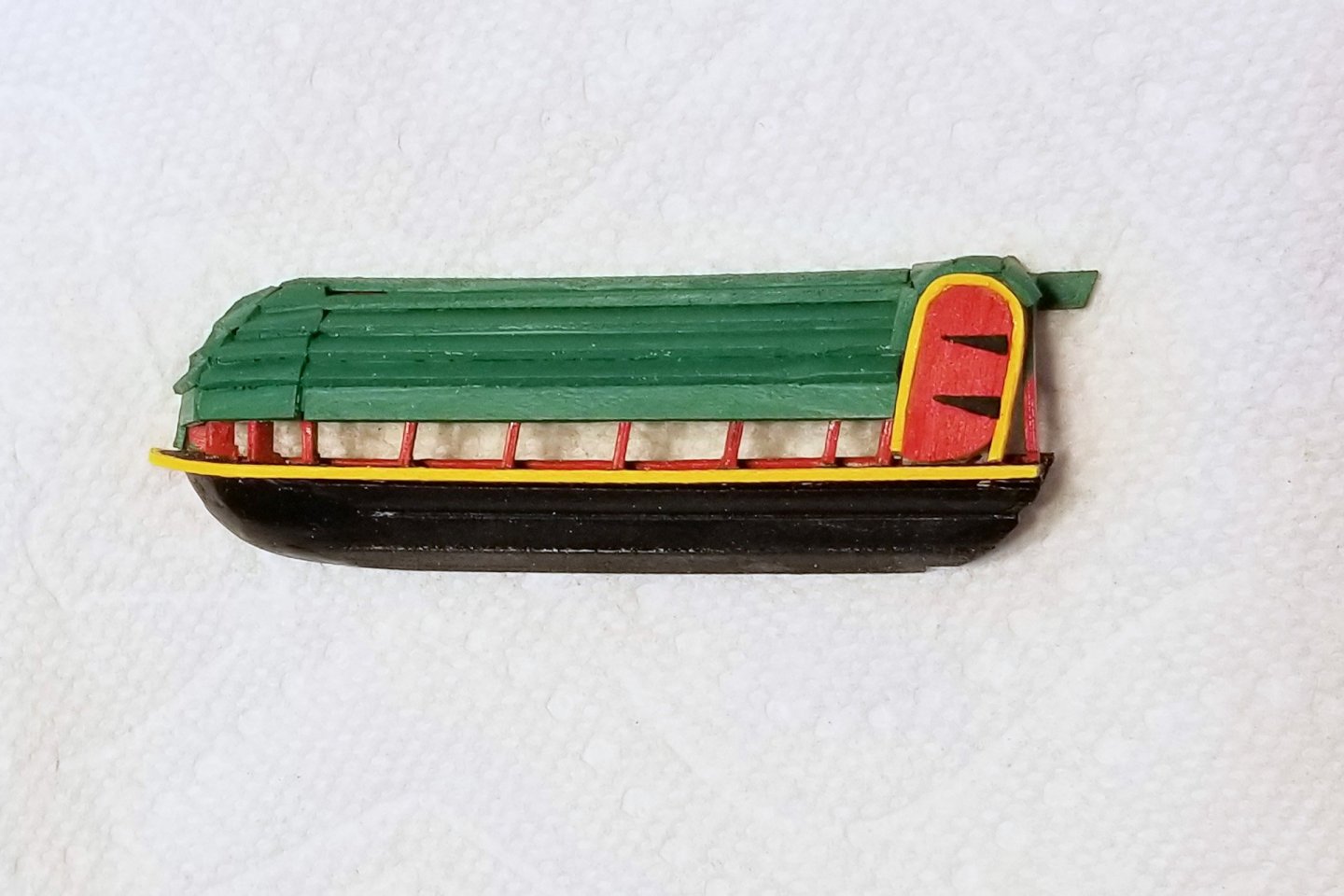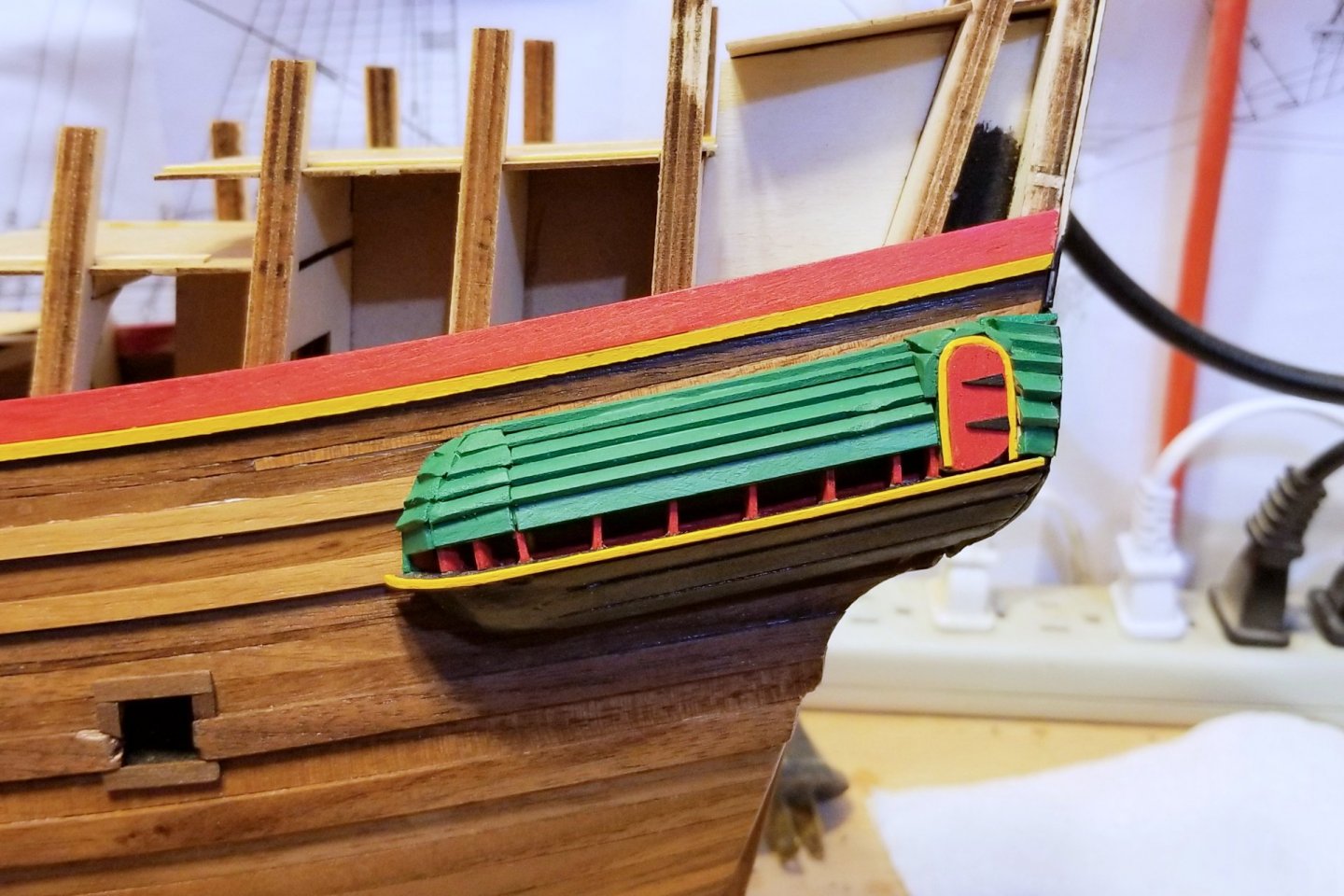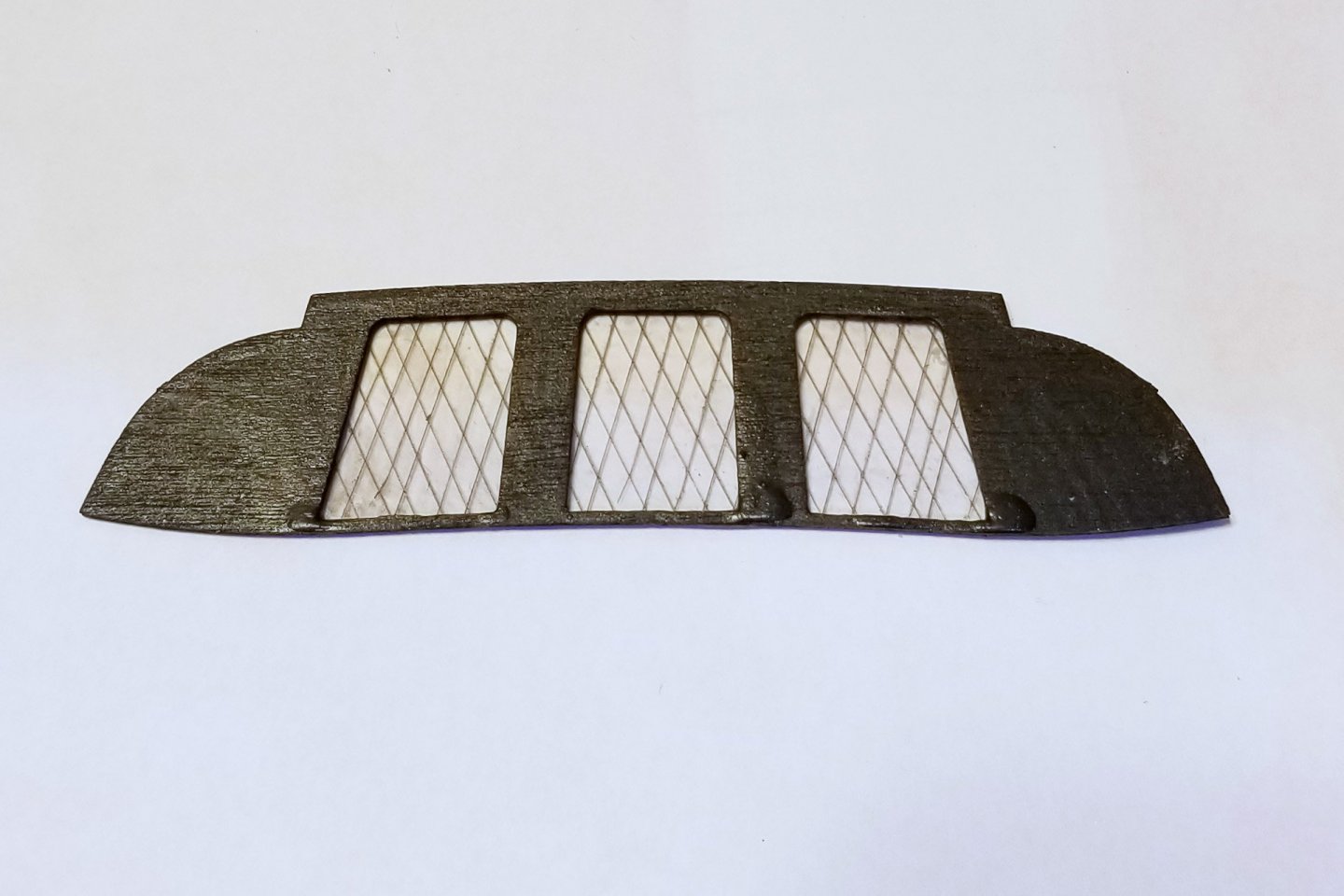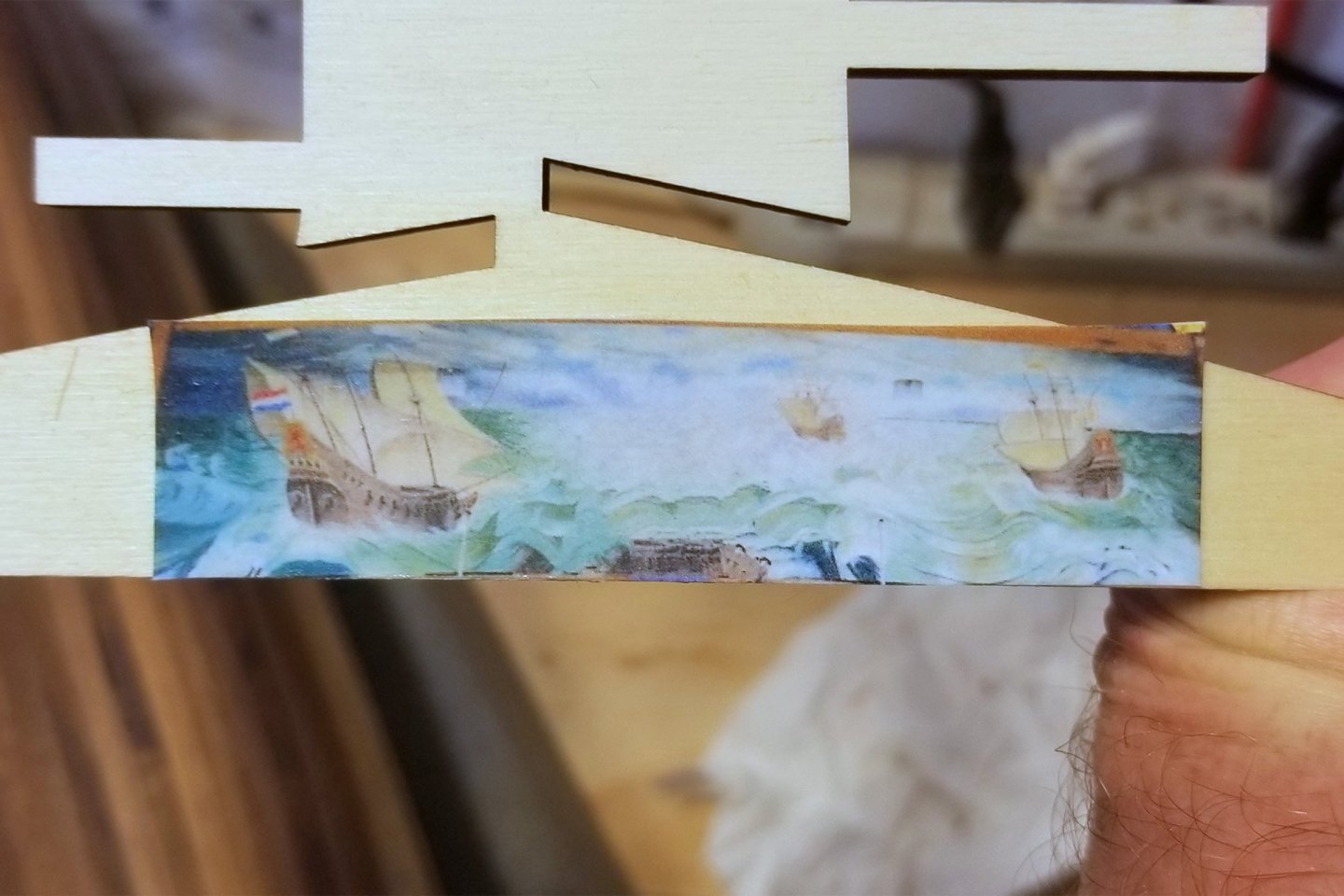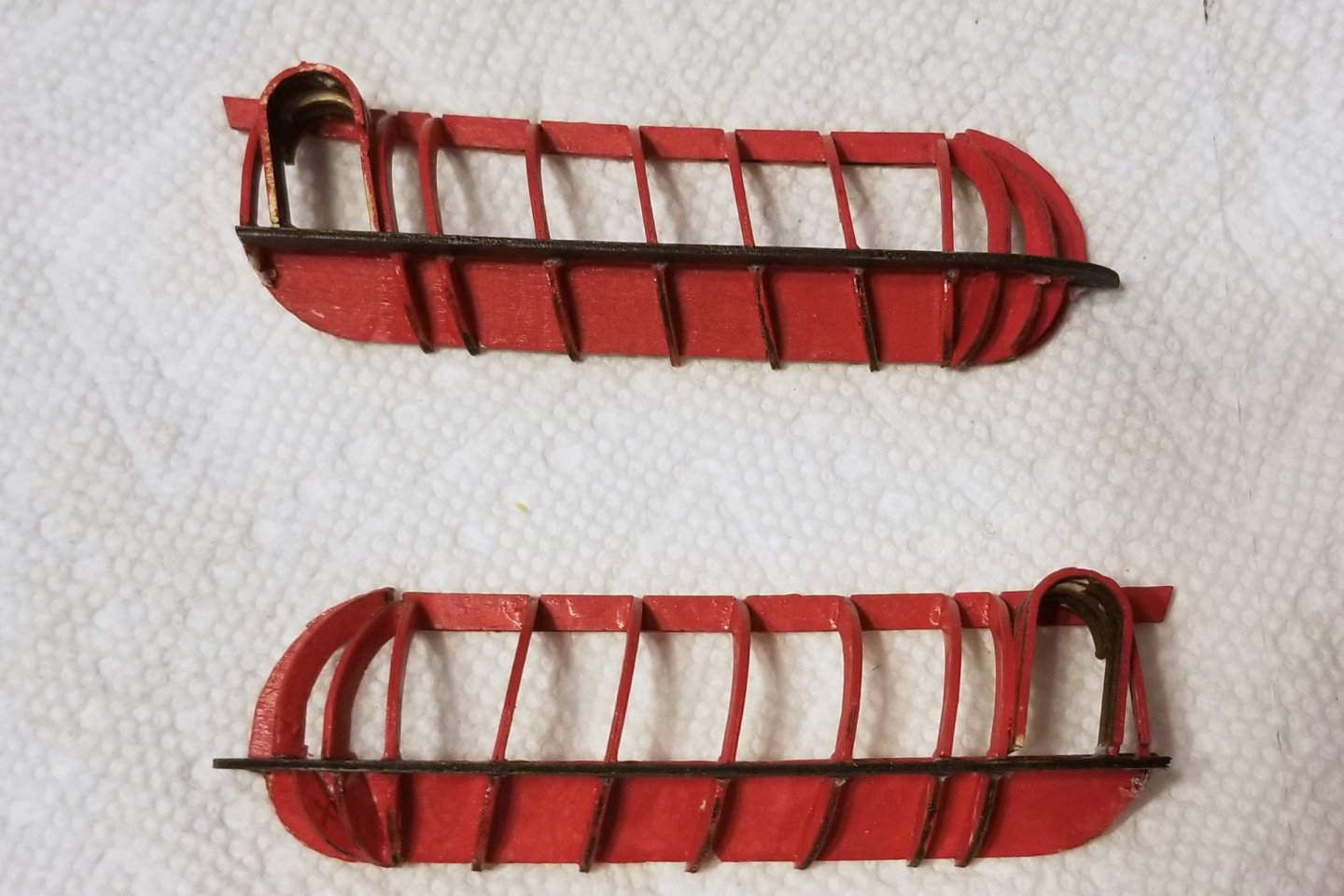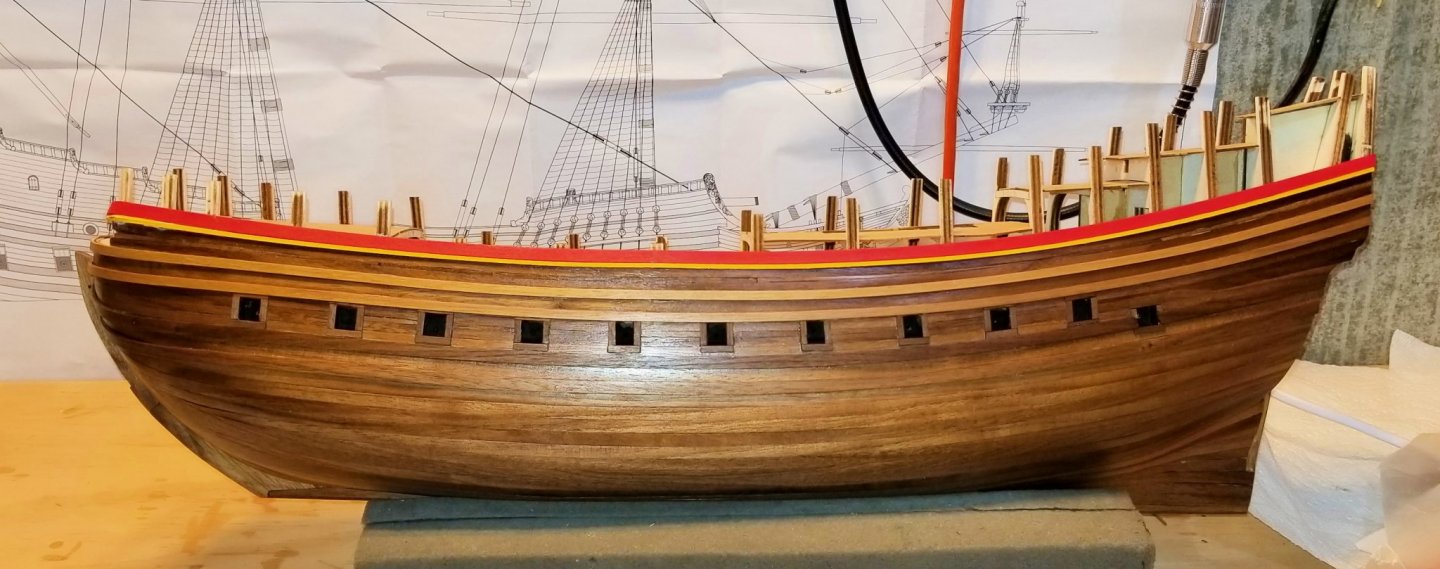-
Posts
1,072 -
Joined
-
Last visited
Content Type
Profiles
Forums
Gallery
Events
Everything posted by drobinson02199
-
Finished the stern railings on the starboard side. In order to line up the last, shorter railing, I had to paint and mount the top of the stern decoration, so that is shown too. My first venture into fine detail painting. Again, the level breaks between the railing sections will be dressed with curved ornaments. For variety, I may do more of the stern decoration before doing the port side railings. Regards, David
- 136 replies
-
- kolderstok
- batavia
-
(and 1 more)
Tagged with:
-
Peter: Thank you -- that's an extremely generous offer. I'm finding that the main value of that log for me is the pictures. They show me colors and the treatment of some intricate builds that are hard to figure out from the plans and manual. But if I need a translation and Google doesn't produce something I can understand, I will certainly call on you. Regards, David
- 136 replies
-
- kolderstok
- batavia
-
(and 1 more)
Tagged with:
-
[I have pictures below that are supposed to follow my text in sequence, but sometimes this site reverses the order or mixes it up, so if it does that, you should still be able to figure it out] I've started on the railings, which are among the most intricate and challenging things I've encountered on any ship -- but fun too. In order to get them right, I built another jig, which is shown below. This one has two purposes: first, to get the initial spacing and orientation right, and second, to support the posts for fine sanding (see below). After painting and striping the bottom rail section, I cut red post sections from a strip of red painted walnut. Those go into the jig as shown. The tricky thing is that it's impossible to keep glue off of the jig, so there's a sort of dance of letting them set just enough to move the assembly out, before they get stuck in the jig. Then a trial fitting with the top strip (which is also the bottom strip for the next section. That indicates where the posts need to be sanded down, and for that the assembly goes back into the jig, and I used the drum sander for that with the jig providing lateral support so that the posts don't pop off. Then there's some alignment checking, gluing the first assembly, and then making the next one (which contains the top rail of the first one) in the same way. What you see in the assembled picture is two sections with the bottom rail of the third (top rail of the second) taped into place to show how the railings look. I have some touch-up to do on one of the rail edges. The challenge is not just building the assemblies, but also getting the post height right and the alignment right between sections. But the result is pretty satisfying. By the way, there are some curved cast resin pieces that dress the area between sections. That's why I didn't worry about running the posts right up to the curve on the lowest section. It may seem like I'm working fast given how quickly I posted this after the last one, but I've actually been doing parts of this in parallel with the hull painting and the last spars, since glue and paint have to dry. But it's now going to take a while to finish the railings on this side and do the other, and then go up to the bow section for more of the same. Regards, David
- 136 replies
-
- kolderstok
- batavia
-
(and 1 more)
Tagged with:
-
Finished the cabin bulkhead at Frame 16 as well as all of the spars on both sides leading back from the main deck. Also painted the unfinished part of the planking a nice green. I should mention that Hans gave me a Dutch build log that's an excellent source of pictures. I don't try to translate the Dutch -- I have just copied down all the pics so I have something to reference, as the ones in the manual don't show everything. That log was, for example, my source for the red deck at the rear. It can be found at https://www.modelbouwforum.nl/threads/bouwverslag-kolderstok-voc-retourschip-batavia-1628.234841/ Regards, David
- 136 replies
-
- kolderstok
- batavia
-
(and 1 more)
Tagged with:
-
Peter -- Yes, I think this will be a beautiful model. The painted colors are the reason I was attracted to this model. Regards, David
- 136 replies
-
- kolderstok
- batavia
-
(and 1 more)
Tagged with:
-
Hans -- Yes I did notice. You had said they would really add stiffness, and they do. The bulwarks are very solid. Regards, David
- 136 replies
-
- kolderstok
- batavia
-
(and 1 more)
Tagged with:
-
Finished installing and painting the spars between frames 9 and 12. The little jig made the alignment come out well. Built and installed the cabin bulkhead at Frame 14. Now I'll do the spars between 12 and 14. As you can see, I'm working my way back to the stern, after which I'll paint the exterior hull and do the railings (which promise to be a real challenge to get right). Regards, David
- 136 replies
-
- kolderstok
- batavia
-
(and 1 more)
Tagged with:
-
Alex and Robert: These are both wonderful sites. Thank you for sending them to me! Regards, David
- 136 replies
-
- kolderstok
- batavia
-
(and 1 more)
Tagged with:
-
I made a jig to help with installing the spars to keep them properly spaced and parallel. Regards, David
- 136 replies
-
- kolderstok
- batavia
-
(and 1 more)
Tagged with:
-
Peter: Welcome aboard! Glad you are interested. You are right -- I am really enjoying this build. It has a number of new differences and challenges from other models I have built, and I really love the way the colors work. The materials quality in this kit is excellent -- on a par with the Amati Victory series, which has been my gold standard for kit quality. Regards, David
- 136 replies
-
- kolderstok
- batavia
-
(and 1 more)
Tagged with:
-
Yankee D -- No problem asking. Regarding the pillars: you are correct when viewing carefully from the photo angle, but from a normal viewing angle you can't tell. Re the ladders: I debated whether to have them standing on the deck (slanted) or vertical and attached to the bulkhead, and chose the latter treatment. Maybe I'll change that for the main deck ladders, which are more visible. Regards, David
- 136 replies
-
- kolderstok
- batavia
-
(and 1 more)
Tagged with:
-
Built and installed the cabin bulkhead at Frame 12. The three pillars are made of molded resin. There are a lot of these parts, and this is the first time I've run across this material. It's a joy to work with -- easy to separate the pieces, and they clean up easily with a file. Regards, David
- 136 replies
-
- kolderstok
- batavia
-
(and 1 more)
Tagged with:
-
Hans -- That's what being in lockdown will do!
- 136 replies
-
- kolderstok
- batavia
-
(and 1 more)
Tagged with:
-
The rest of the side planking is up. This is overlapped, clapboard-style. Goes up pretty quickly. Next step will be to remove the frame ribs and start working on the cabin bulkheads and spars on the side. I want to do those before painting the exterior as I'll need to sand the spars down to be level with the top of the sides. Regards, David
- 136 replies
-
- kolderstok
- batavia
-
(and 1 more)
Tagged with:
-
Three hatches done. The two red ones are simulated canvas using T-Shirt material and paint. The wooden one on the quarterdeck was difficult. I had trouble with glue adhesion on the hatch material, and also with sanding. Did the best I could and then varnished it, and what I got was a "weathered" hatch, which looks fine on the boat -- better than in the pic. Regards, David
- 136 replies
-
- kolderstok
- batavia
-
(and 1 more)
Tagged with:
-
Spars installed on the side bulkhead. One picture pre-painting to show the pattern, and one after painting. There will be a cap rail on top. Regards, David
- 136 replies
-
- kolderstok
- batavia
-
(and 1 more)
Tagged with:
-
I referred in my post above to the "box" across the side bulkhead. Here's how I built it: I created a simple jig to get the top of the box level. Prepainted the ends so I wouldn't have to paint near the green cabin bulkheads Glued the top to the side bulkhead, covering the rib stubs Prepainted a soffet (for a clean line at the deck) and glued it on. Now I can install the spars on top of the box and then paint it all black. I'll use this same approach on the other decks as I move up. Regards, David
- 136 replies
-
- kolderstok
- batavia
-
(and 1 more)
Tagged with:
-
Finished the cabin bulkhead at Frame 9. First, I had to build up the side planking a bit so that I could paint the inside corner black. Then I painted and installed the two side bulkheads and the span between them. What's left is the unfinished side bulkhead. Next step is to build a "box" to cover the area where the ribs were removed, then install spars and paint it all black. Regards, David
- 136 replies
-
- kolderstok
- batavia
-
(and 1 more)
Tagged with:
-
Bluebeard -- Glad to hear it. This means that my many mistakes will have some lasting value. 😄 Regards, David
- 136 replies
-
- kolderstok
- batavia
-
(and 1 more)
Tagged with:
-
Hans: Is that because your "bad" side wasn't actually bad, or because your eyesight is going with age (like mine) 😜 Regards, David
- 136 replies
-
- kolderstok
- batavia
-
(and 1 more)
Tagged with:
-
Now the starboard gallery is done. I did some surgery on the framework where it meets the stern that allowed me to get the short connecting planks straight on this side -- which is my "good" side. Regards, David
- 136 replies
-
- kolderstok
- batavia
-
(and 1 more)
Tagged with:
-
For something different to try before working on the starboard gallery, I decided to do one of the cabin bulkheads, and it really illustrated for me the importance of getting the sequence right on this model. I built the cabin bulkhead off the model. But in order to mount it, I needed to paint the corner black (the rest of that side bulkhead will be black) so I didn't mess up the green planking on the cabin bulkhead, and in order to do THAT, I needed to start the green overlapped planking toward the bow. You can see the sequence requirement in the pictures. The rough areas where the frame ribs were removed will be covered over with a long "box", but I didn't want to install that first as it would require cutting into the cabin bulkhead. I have seen pictures of other models that painted this cabin bulkhead black (and the other ones to come), but I really like the green color on this boat, and the side bulkheads will be black, so it's a nice offset (even if not authentic to the real Batavia). Regards, David
- 136 replies
-
- kolderstok
- batavia
-
(and 1 more)
Tagged with:
-
[NOTE: Pictures loaded in reverse order relative to the text, which this site sometimes does] Continuing with the galleries, I have finished the port side gallery. The port side is slated to be facing the wall, so it's my "try it first" side for complex parts of the build or things I'm not quite sure how to work through -- and this was one of those. The galleries are a fun detailed challenge, and something of an engineering challenge to be sure they fit on the boat properly. I posted the frameworks in my previous post -- I then planked and decorated them off the ship -- you can see that in the attached picture. Note the end of the top rail that you can see at the top right. This rides along the top wale and if you have followed the "tic marks" on the frames during planking (see my earlier posts), then the galleries line up with the stern parts (at least at the bottom). There's also a pic of the port gallery mounted on the ship. The top side planking that joins to the ship at the stern is the only part done on the ship, and you can see why -- I had to plank down a bit to get the alignment right. This gallery begins to show the color scheme of the ship -- and it will pick up some additional fancy decoration later on when I glue on the resin figurines provided in the kit. They will be yellow and that will look terrific against these colors. Regards, David
- 136 replies
-
- kolderstok
- batavia
-
(and 1 more)
Tagged with:
-
A few odds and ends getting ready for the galleries and their intersection with the stern: "Leaded glass" on the rear windows, made by scoring acetate and then washing it with diluted black paint. A decoration for the stern. This doesn't come with the kit: I took it from a stern-on shot of the real Batavia, and then photoshopped it into the right size. This one you see is a test -- I wanted to see how the printer inks reacted when varnished. They do fine, so when ready I can print another copy and mount it on the stern. The gallery frames -- ready for planking. Regards, David
- 136 replies
-
- kolderstok
- batavia
-
(and 1 more)
Tagged with:
-
Now we begin to get to the reason I was interested in this model. The colors are beginning to go on. Side planking turns green from here up with red and yellow accents. Regards, David
- 136 replies
-
- kolderstok
- batavia
-
(and 1 more)
Tagged with:
About us
Modelshipworld - Advancing Ship Modeling through Research
SSL Secured
Your security is important for us so this Website is SSL-Secured
NRG Mailing Address
Nautical Research Guild
237 South Lincoln Street
Westmont IL, 60559-1917
Model Ship World ® and the MSW logo are Registered Trademarks, and belong to the Nautical Research Guild (United States Patent and Trademark Office: No. 6,929,264 & No. 6,929,274, registered Dec. 20, 2022)
Helpful Links
About the NRG
If you enjoy building ship models that are historically accurate as well as beautiful, then The Nautical Research Guild (NRG) is just right for you.
The Guild is a non-profit educational organization whose mission is to “Advance Ship Modeling Through Research”. We provide support to our members in their efforts to raise the quality of their model ships.
The Nautical Research Guild has published our world-renowned quarterly magazine, The Nautical Research Journal, since 1955. The pages of the Journal are full of articles by accomplished ship modelers who show you how they create those exquisite details on their models, and by maritime historians who show you the correct details to build. The Journal is available in both print and digital editions. Go to the NRG web site (www.thenrg.org) to download a complimentary digital copy of the Journal. The NRG also publishes plan sets, books and compilations of back issues of the Journal and the former Ships in Scale and Model Ship Builder magazines.



